PinotFile: 10.33 July 6, 2016
|
Oregon Chardonnay Gaining Prominence
huge steps forward for those obsessed with making great Chardonnay.” Erica Landon
The following people offered invaluable information for this article based on their experience with Oregon Chardonnay as well as their knowledge of the evolution of Oregon Chardonnay over the past fifty years. Jason Lett (proprietor and winemaker, The Eyrie Vineyards), Brian Marcy (proprietor and winemaker, Big Table Farm), David Adelsheim (proprietor of Adelsheim Vineyard), John Winthrop Haeger (writer and consultant, and author of North American Pinot Noir), Erica Landon (former Portland-based sommelier and founding partner of Walter Scott Wines), and the vintners who participated in and expressed their opinions in the past Oregon Chardonnay Symposiums and Oregon Chardonnay Celebrations. Valuable resources for the history of Chardonnay clones include Gerald Asher’s article in Gourmet, May 1990, “Chardonnay: Buds, Twigs and Clones,” and The FPS Grape Program Newsletter, November 2007, “Chardonnay History and Selections at FPS.”
Looking Back for Insight into “Bad Then Good Now”Pinot Noir is unquestionably Oregon’s signature red grape, and Pinot Gris has been Oregon’s most popular white wine. Today, Pinot Gris acreage still outnumbers Chardonnay plantings by two to one, but Oregon Chardonnay is quickly carving out its own popularity as vintners gain more traction with this varietal.
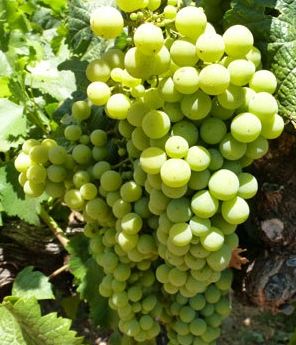 Any discussion of the evolution of Oregon Chardonnay must dispel the commonly held myth that Oregon Chardonnay has never been very good and only in recent years has it achieved enough excellence to be considered equal in quality to Oregon Pinot Noir. As recently as 2015, dmagazine.com reported, “Chardonnay grown in the Willamette Valley until recent years has been rather flabby, flat and uninteresting.” The truth is that some wineries in Oregon have always been successful with Chardonnay, but not all were. The so-called resurgence of Oregon Chardonnay hasn’t exactly been a modern rebirth, but a confluence of a number of factors that have improved upon the potential that was always evident, including changes much more important than Chardonnay clones. To quote winemaker Jason Lett of The Eyrie Vineyards, “Oregon Chardonnay was always good when it was grown by people who understood Chardonnay.” In the early years of Oregon’s emergence as a world-class wine region, there were a few vintners who took Chardonnay seriously from the beginning and their wines achieved notable recognition. David Lett is highly honored for not only the first plantings of Pinot Noir and Pinot Gris in the Willamette Valley, but also the initial plantings of Chardonnay. David realized that Chardonnay, like Pinot Noir, were well suited to the Region I climate of the Willamette Valley and after heading north to Oregon from California in late 1964, he found a suitable site for a nursery just outside of Corvallis in February 1965. The first plantings of Pinot Noir and Chardonnay in the Willamette Valley and the first Pinot Gris outside of Europe were established on February 22, 1965.
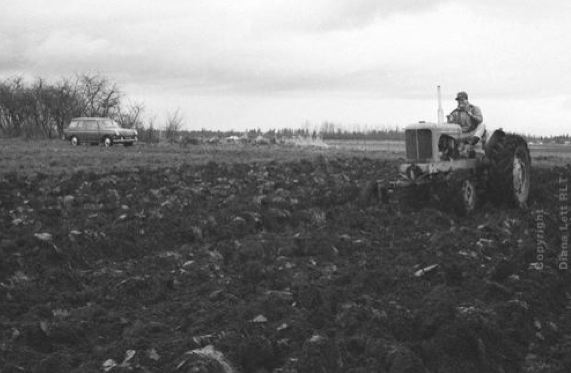 While still in California, David had visited the Draper Ranch in St. Helena and toured the vineyards where longtime vineyard manager Joe Torres showed him certain blocks and vines that were his favorites. This Chardonnay fruit went primarily to Souverain Cellars on Howell Mountain where winemaker Lee Stewart made storied Chardonnays. Jerry Draper, Lee Stewart and Fred McCrea (Stony Hill) had all planted vineyards on the hillsides of Spring Mountain in Napa Valley in the 1940s using cuttings of OId Wente Chardonnay that had been sourced from Herman Wente at Wente Vineyards in Livermore (the Wente vineyards at the time were composed of Chardonnay from budwood that a member of the Wente Family - reportedly Ernest - took from the University of Montpellier vitiicultural nursery and cuttings taken from the Gier Vineyard which had used some of Charles Wetmore’s plantings at La Cresta Blanca Winery that purportedly were cuttings from Meursault in Burgundy). Louis Martini, Jr., would later take budwood he called Wente clone from McCrea’s Stony Hill Vineyard for planting at Stanly Lane Vineyard in Carneros in 1951 or 1952. Dr. Olmo, a faculty member at University of California at Davis brought disease-free selections from Stanly Lane Vineyard to Foundation Plant Services (FPS) in 1964. Olmo #66 and Olmo #69 would later become Chardonnay FPS 04 and 05. The Draper selection of Chardonnay along with UCD selections became the basic vines of The Eyrie Vineyards. David Lett initially sold Chardonnay cuttings to other Oregon vintners, but discontinued this practice after 1974. He only made two Chardonnays entirely from clone 108 (see below), in 1978 and 1980. When a retrospective tasting of pristine bottles of Lett’s The Eyrie Vineyards Chardonnays was held July 23, 2009, the quality and age ability of the older wines was impressive. Before the tasting, winemaker Jason Lett had gone through the entire library of Eyrie Chardonnay and eliminated those bottles that had cork taint and oxidation, both of which were more common then met with today. This would suggest that some of the early disappointing reports of Oregon Chardonnay could be blamed on cork issues. As an example of the high quality of The Eyrie Vineyards Chardonnay of the 1980s, the 1985 The Eyrie Vineyards Chardonnay tied for third place with 1985 Talot-Beaut Corton-Charlemagne in a tasting of Chardonnays at the International Wine Center in New York. Other Oregon vintners sought out Chardonnay selections from California in the early 1970s including William (Bill) Fuller at Tualatin Estate Vineyards in Forest Grove who released his first Chardonnay in the mid 1970s. His 1981 Chardonnay won Double Gold and Best of Show trophies in a prestigious international wine competition and his Chardonnays, along with those from The Eyrie Vineyards, were considered the best in Oregon by Robert Parker, Jr., during the 1980s. Wente selections planted at Bethel Heights, Rex Hill and other wineries did get ripe and performed beautifully.
 Oregon vintners of the 1970s and 1980s planted Old Wente selections, heat-treated Wente clones 04 and O5 that were registered at FPS in 1973, and heat-treated clone 108 which preceded the release of Wente clones 04 and 05. Clone 108, also known as the “Davis” or “Wente” clone was first released in 1967 by the University of California at Davis (UCD). It was considered ideal for California vineyards because of high yields, lower acidity and lacked the undesirable “hens and chicks” tendency of the Old Wente selection. UCD 108 was a combination of 04 and 05, consisting of different mother vines that underwent heat treatment at the same time (Chardonnay was one of the first varieties that was subjected to thermotherapy at UCD). It’s popularity led to accolades such as published in April 1994 in Wines & Spirits, “The dependable high-yield clone #108 accomplished the goal of making Chardonnay commercially viable in California.” The widespread success in California led to its spread to other states including Oregon, but the Oregon wines were often said to be simple and uninspired. The idea that California heritage Chardonnay clones were not appropriate for Oregon developed and persisted. In North West Wine Update May/June 1996, it was noted, “The cooler-climate Dijon clones are more suitable to this region than the popular warm climate oriented clone 108, and combined with terroir oriented winemaking, result in truly exceptional wines as more of a rule and less of an exception. John Winthrop Haeger recalls in Oregon’s pre-Dijon era, while doing a commissioned magazine article on Oregon Chardonnay, that Oregon vintners repeatedly told him that the Wente selections were to be blamed for the poor quality of early examples of Oregon Chardonnay. Haeger suspected that there was too much consensus with too many people talking to each other and felt like this was too easy an explanation for some disappointing Oregon Chardonnays. However, vintners like David Adelsheim and Harry Peterson-Nedry were strong critics of the California heritage Chardonnay clones. In 2008, Adelsheim noted in Wines & Vines, “Chardonnay clonal selections from California are not working right in the cooler Oregon Climate.” Clone 108 in particular was met with disappointment in Oregon due to many factors beyond its clonal identity. Although Wente Chardonnay clones are highly adaptable and particularly suited to Winkler Region I climate found in Oregon’s Willamette Valley, clone 108 reportedly ripened too late, and this drawback combined with its high yields led to some examples of Oregon Chardonnay that were austere, acidic and lacked interest. However, this was before the appearance of crop thinning. Gerald Asher pointed out in 1990 that clone 108 could perform if yields were kept to a certain maximum amount such as three or four tons per acre. Another factor was that clone 108 was heat treated Wente clones 04 and 05 and it is well known that heat treatment can significantly alter the pre-treatment character of the original clone.
 Despite the lack of widespread success of the Wente selections in Oregon in the 1970s and 1980s, there were many Oregon Chardonnays based on these California Chardonnay selections that excelled. Insight into the quality of Oregon Chardonnay in the early years can be obtained by viewing old editions of Robert Parker, Jr.’s, Wine Advocate. In 1985, Parker exclaimed, “Based on the tastings I have just completed, Oregon is about to catapult into stardom not just for its startling pinot noirs, but also for its chardonnays. The chardonnays are remarkably similar to their French counterparts, and as my blind tastings proved, often impossible to pick out as being made in the USA. For chardonnay, Tualatin, Shafer and Eyrie produced stunning wines in both 1982 and 1983, and Peter Adams, Adelsheim, Ponzi, Knudsen Erath, Sokol Blosser and Alpine have all proven they can do something special with chardonnay given a good vintage.” Two years later, in 1987, Parker penned an article titled, “Oregon: Current Releases (Time to Take Notice).” He remarked, “Their (Oregon’s) chardonnays seem to be getting better and better and some of them will out age anything California can produce.” He listed Oregon’s best Chardonnays in order of overall quality: Tualatin, Eyrie, Adams, Shafer, Ponzi, Giradet, Veritas, Rex Hill, Adelsheim, Amity, Cameron, Sokol Blosser and Elk Cove. Parker’s praise was tempered by his comments on oak management, “In Oregon there seems to be a tendency to obliterate the great fruit they got in 1983 and 1985 with loads of toasty new oak. However, there are some excellent, very French like, very age worthy chardonnays coming out of Oregon from half a dozen wineries. By 1987, the Oregon Vineyard and Winery Report indicated that Chardonnay had overtaken White Riesling in bearing acreage with 733 acres, becoming the most widely planted white variety, and second only to Pinot Noir’s 904 bearing acres. Oregon wineries crushed 1,013 tons of Chardonnay, 25.4% of the total crush, second only to Pinot Noir at 1,447 tons or 36.4% of the total.

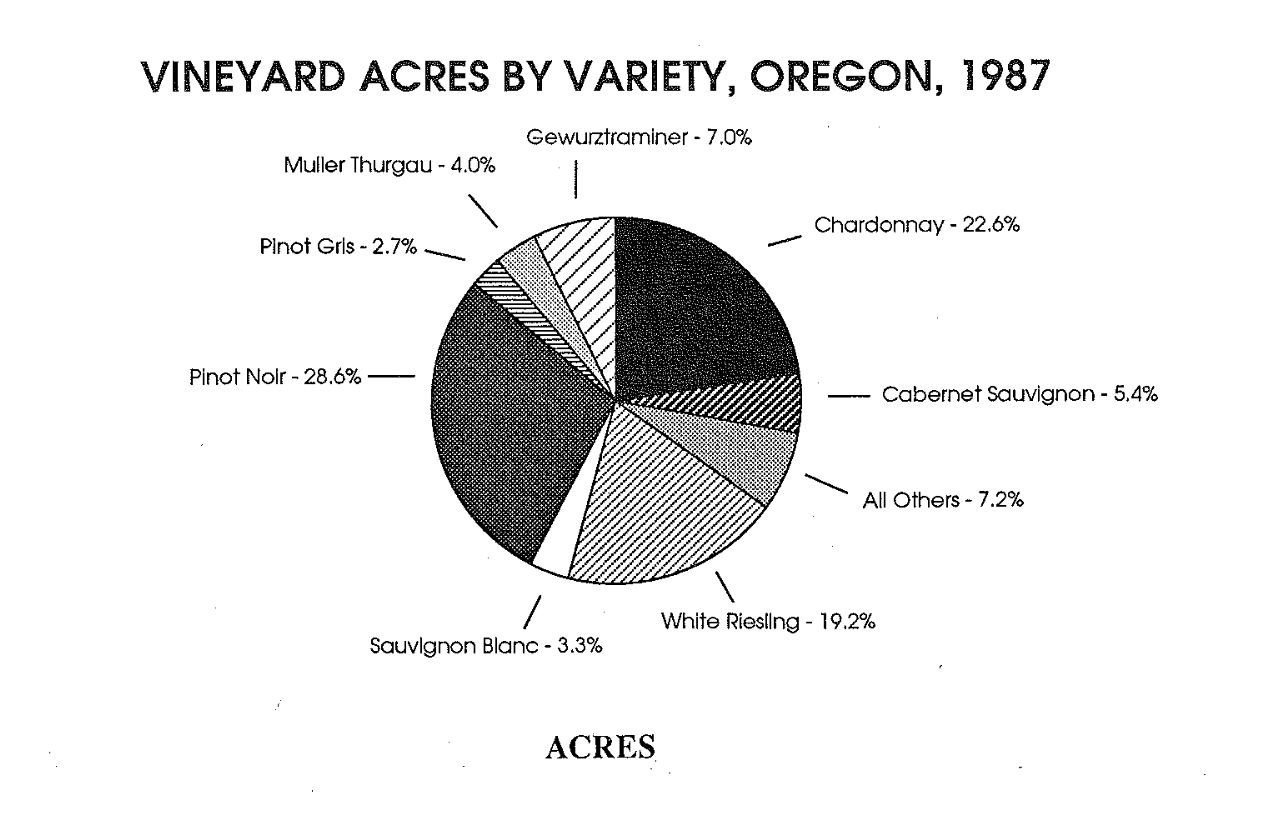 The true history of the events that led to the importation of the so-called French Dijon clones of Pinot Noir and Chardonnay into Oregon has been misstated in the wine literature, and multiple untruths regarding dates and contributors have been propagated through the years. I asked David Adelsheim, someone with an excellent memory who was a central figure in the story of how the Dijon clones arrived in our country, to clarify the chronology of events. For the purposes of this article, the focus is on the Dijon clones of Chardonnay. While in Burgundy in 1964, David Lett met Professor Raymond Bernard, a viticulturist and regional director of the Office National Interprofessional des Vins (ONIVINS) and established a collaborative relationship . The Oregonians knew about Bernard’s program and had much of his research data. David Adelsheim was an intern at the Lycée Agricole et Viticule in Beaune for the 1974 harvest. The Lycée had a block with new clones planted in Puligny, that Adelsheim visited and from which he helped make wines that year. He told me, “The main thing that dawned on me in 1974 was I realized that the Chardonnay clones in Burgundy ripened with Pinot Noir, not two weeks later as the UCD clones 4 and 5 did back home in Oregon.” On the same trip in 1974, Adelsheim went to the Domaine de L’Espiguette (Association Nationale Technique pour l’Amélioration de la Viticulture) on the Mediterranean near Montpelier. He met with the person in charge of their virus cleanup program, Claude Valat, and requested clones of Pinot Noir, Chardonnay and Gamay Noir be sent to the fledgling import program at Oregon State University (OSU). Valat sent three clones of Pinot Noir, two of Chardonnay (77 and 352) and four of Gamay. One clone of each variety failed the indexing tests, but 352 made it into Oregon and has been planted here and there. Adelsheim notes that it makes incredible sparkling wine. Back in Oregon, Adelsheim pushed Ron Cameron, a plant pathologist at OSU, to obtain a grape import permit from the USDA, since Austin Goheen at FPS did not feel there was a need to import any more Pinot Noir material to UCD. David Heatherbell, who was from New Zealand, was appointed Professor in the Food Science Department at OSU, focusing on enology. He came to Corvallis after time in Burgundy in 1983 and set up a visit with Raymond Bernard. He asked for a range of clones of Pinot Noir and Chardonnay to be evaluated against those that were already in Oregon. Heatherbell did this because Porter Lombard, another OSU Professor (in Horticulture) had been communicating with Bernard at the request of Adelsheim and others about the need for French clones of Pinot Noir and Chardonnay in Oregon. In January 1984, Bernard sent nine clones of Pinot Noir and 4 clones of Chardonnay to Ron Cameron. They were sent in a package with a return address of “Dijon, France.” When Adelsheim first saw the clones in a greenhouse in Corvallis, the French clones were all numbered with a “D” in front of them. The name, “Dijon clones,” has now become a part of the viticulture lexicon. The initially imported Chardonnay clones were 75, 76, 78 and 96. The second set of Chardonnay clones, 95 and 277 (along with Pinot Noir clones 667 and 777), arrived at the beginning of 1988 through the OSU import license. Adelsheim had visited Bernard in his office in 1987 and requested the additional clones. Clone 277 was confused with the two Pinot Noir clones and was lost. The French clones were sent to FPS in 1987-88 where they underwent shoot tip tissue culture treatment and released as registered FPS selections between 1997 and 2002 (Adelsheim can’t confirm this but said, “It sounds right.”). Small amounts of the Dijon Chardonnay clones were released in 1990 from the nursery at OSU. The clone 95 lagged behind because it was rushed through quarantine in two years and there had been no propagation going on. The new Dijon Chardonnay clones were planted in earnest in the 1993 to 1995 seasons. Clones 75 and 78 were never significantly planted. The importation of the Dijon clones of Chardonnay into Oregon is looked upon by some as a lifesaver for Oregon Chardonnay. David Adelsheim observed early on that California was more successful than Oregon in making Chardonnay. He felt that the French clones offered advantages over the California heritage clones in Oregon. The clones produced naturally lower yields, the clusters were smaller, the grapes had unctuous fruit intensity (allowing more new oak if desired), the resultant wines demonstrated good fruit quality and crispness, and most importantly, the clones had early ripening dates. The Dijon clones that were sent to Foundation Plant Services (FPS) at UCD from OSU in 1987-88 are considered “generic” since they preceded the establishment of the ENTAV-INRA™ program for official French clones, and are given a different FPS selection number than the reported French number. The clones underwent shoot tip tissue culture treatment and were released on the FPS registered list between 1997 and 2002. These treated clones have the same FPS numbering: ENTAV-INRA™ French clones 76 and 96 are equal to FPS clones 76 and 96. There are 34 Chardonnay clones officially certified by ENTAV-INRA™ with the most popular being 96, 76, 95, 277 and 548. Clones 77 and 809 are popular French clones of the musqué type. FPS also now offers FPS 72 (former FPS 2A), a heat-treated version of Old Wente selection.


 The Dijon clones of Chardonnay quickly became popular in Oregon because they ripened earlier before Oregon’s notoriously bad weather encroached on the end of harvest, the clones had more flavor-concentrated clusters, balanced acidity, and offered vintners a reliable alternative. Sommelier Erica Landon commented, “While I agree that Dijon clones are not what is fueling this revolution in Oregon Chardonnay, I do not think you can deny that the introduction of commercially available high quality Chardonnay clones that were better suited for our (Oregon) climate had an impact on elevating the general quality of Oregon Chardonnay.” Clone 96 has become the most frequently propagated Dijon Chardonnay clone in Oregon. It is evident from this table below sent to me by Jason Lett that Oregon Chardonnay vineyard acreage spiked in the mid 1990s after the introduction of the Dijon clones of Chardonnay. The acreage dipped somewhat after 1998 due to the popularity of Pinot Noir and Pinot Gris, but has again shown an increase, and as of 2014, according to the Oregon Vineyard & Winery Census Report, there are 1,353 planted acres of Chardonnay in Oregon, with the majority located in the Willamette Valley.
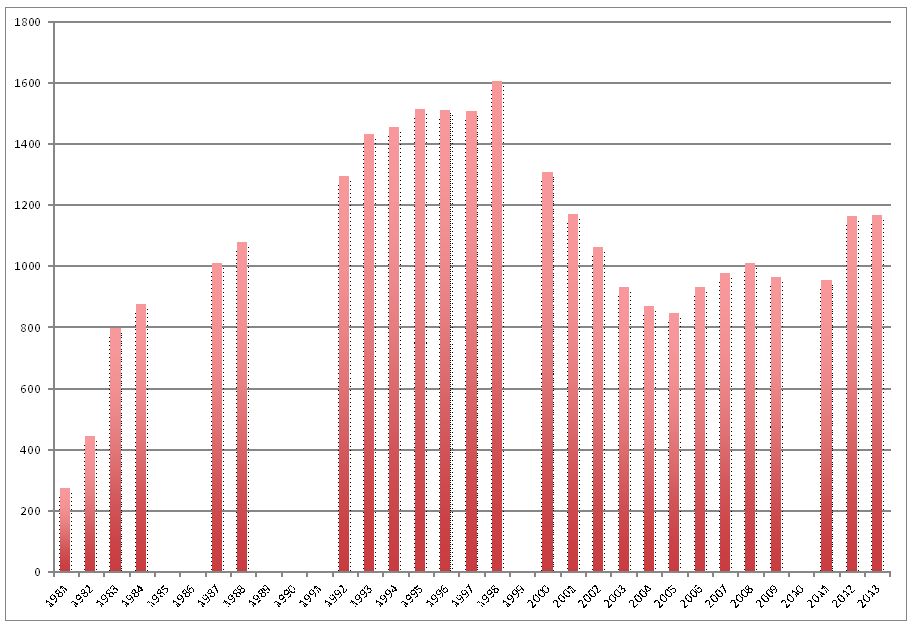 The purported failure of Oregon Chardonnay in the past can be attributed to many factors. Early on, many Chardonnay plantings ended up on lesser sites and the vines were not cropped and otherwise farmed appropriately. There were only a few vintners who took Chardonnay seriously and committed to it wholeheartedly as many looked upon it as a commodity wine. Many wines were overlain with too much oak and over manipulated, a result of an attempt to emulate the popular California style of Chardonnay. Finally, the popularity of the Dijon clones coincided with renewed commitment by some, but not all wineries. Jason Lett told me, “Perhaps not everyone who planted these ‘easy new clones’ in the 80s and 90s were ready for the kind of work it takes to make and market great Chardonnay.”
The Present and Future of Oregon ChardonnayCurrently, the clonal wars have reached a truce among some Oregon vintners, as they realize that specific clones are not as important as they are made out to be. As Erica Landon said to me, “From our perspective, the changes in Oregon Chardonnay quality are much bigger than clones, they encompass Chardonnay from the vineyard to the bottle.” The focus is more on site than clone now which is where it should be. For several decades, the best sites in the Willamette Valley were planted to Pinot Noir with Chardonnay ending up in the lesser sites because the economic return was much less. Erica went on to say, “Some believed in Chardonnay and planted great vineyards early on, but most did not, and most followed trend and money.” There still is a place for the Wente clones, including clone 108, in Oregon. Noted winemaker and winegrower, Robert Brittan said at the 2014 Oregon Chardonnay Symposium, “Don’t give up on clone 108 - it can be in interesting tool.” Winemaker Brian Marcy of Big Table Farm, who crafts some of Oregon’s most engaging Chardonnays, told me, “I have heard that some people are planting a little bit of UCD 108 now, probably for the same reason that I like it. However, I think it will continue to only play a minor role.” Some current Oregon proponents of Wente clone Chardonnay include Jay Christopher of J. Christopher Wines, Todd Hansen of Longplay, Tyson Crowley of Crowley Wines, Josh Bergstrom of Bergstrom Winery, Jim Maresh of Arterberry Maresh, and Jason Lett of The Eyrie Vineyard. Many vintners in Oregon have chosen to work with both older California selections and newer plantings of Dijon clones. Brian Marcy speaks for many who say, “I am happy to have both because they complement each other beautifully to make complete wines. The older plantings bring an acidic backbone that blends well with the unctuousness of the Dijon clones.” Erica Landon pointed out to me the dramatic changes that are currently going on with Chardonnay plantings in Oregon. “You are seeing great sites planted entirely to Chardonnay, with thought going into rootstock, clones and planting techniques. These vineyards are farmed with the utmost care. The viticulturists are learning what works best for Chardonnay here and pushing the standards to a higher level. We are learning how canopy management can have a huge impact on Chardonnay quality, how to pinpoint harvest dates that hit the pH and acid balance that we are hoping for, and not cutting any corners.” Some of the most exciting new Chardonnay vineyards include multiple clonal selections, a selection messale approach rather than one or two clones, and include both Dijon clones and heritage selections from California including Old Wente. Craig Williams of Joseph Phelps fame has planted vineyards in the Eola-Amity Hills AVA including X Novo Vineyard that has fifteen different Chardonnay clones, Josh Bergstrom is planting a new block of Chardonnay at his Silice Vineyard with over fifteen clonal and rootstock combinations, and Luisa Ponzi has planted a mixed clonal vineyard. Tai Ran Niew of Niew Vineyards began planting 5.5 acres of Chardonnay on an 80-acre site in the Chehalem Mountains in the fall of 2015 using a diverse mix of clones. A former aeronautical engineer raised in Singapore, he is using his science background and several years of viticulture and wine studies to focus on and produce age worthy Oregon Chardonnay.
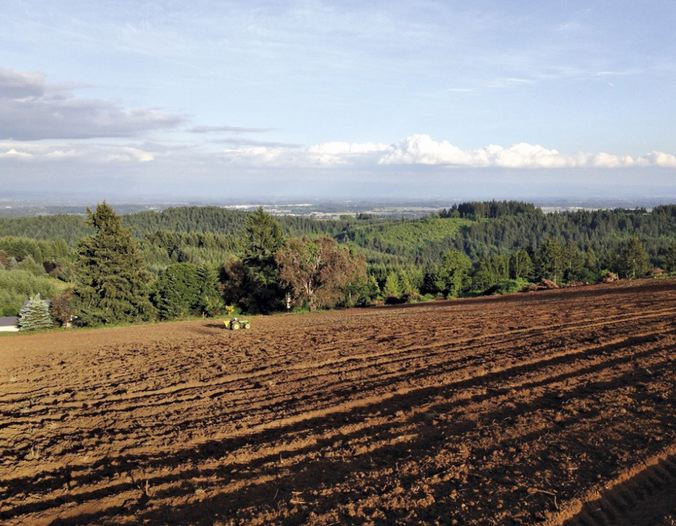 There remains a cadre of Oregon vintners totally committed to the Dijon clones of Chardonnay. These growers belong to the ORegon Chardonnay Alliance (ORCA) that was formed in 2000 with seven original members including Adelsheim Vineyard, Argyle, Chehalem, Domaine Drouhin Oregon, Domaine Serene, Hamacher and Ponzi. A number of other wineries making Chardonnay from Dijon clones have joined ORCA as well. The goal of ORCA is to exchange information and promote Chardonnay to the trade and media, with the marketing story that Oregon Chardonnay was drab until Dijon clones came along to make a difference. The ORCA website previously offered this sweeping statement, “The early Oregon Chardonnays were generally lackluster, eliciting little passion and excitement. So inconsistent were the wines that many producers publicly announced their intention to take out their Chardonnay vines and plant other varieties." ORCA membership requires that the winery be committed to the Dijon clones of Chardonnay. ORCA’s website, www.oregonchardonnay.org is currently under construction. The Facebook page is live at www.facebook.com/OregonChardonnay but offers very little information. Dramatic changes are also occurring in the wineries, with some winemakers such as Ken Pahlow of Walter Scott Wines spending as much time, if not more, working with Chardonnay compared to Pinot Noir. He is bottling several site-specific Chardonnays, trying to learn about how the combination of different soils, aspect, clones, rootstocks and farming techniques are reflected in the finished wines. Erica Landon has pointed out, “Winemakers are fine tuning their decisions such as battonage, inoculation, malolactic fermentation, barrel selection, cellaring and finding out what works best for Oregon and their own style. And, most importantly, they are sharing knowledge with each other, pushing each other to grow and make better wines, and pushing to find what Oregon Chardonnay looks like, rather than trying to emulate California or Burgundy.” Oregon winemakers, led by David Adelsheim and Sam Tannahill, have started an annual Chardonnay Technical Seminar to further raise the level of quality of Chardonnay in Oregon. The yearly tasting focuses on topics such as reductive versus oxidative winemaking and native yeast versus inoculated fermentations. The Oregon Chardonnay Symposium has grown in stature and is now under the auspices of the International Pinot Noir Celebration, along with a name change in 2015 to the Oregon Chardonnay Celebration. Held each year in February, this event has attracted upwards of 300 attendees to The Allison Inn & Spa in Newberg for the seminar and tasting. Oregon vintners at the 2014 Oregon Chardonnay Symposium noted that it will take at least another twenty years to find the optimum combination of site, clone, rootstock and winemaking techniques to realize Oregon’s full potential for Chardonnay. A signature style of Oregon Chardonnay is slowly emerging. The wines tend to have less “makeup,” with new oak limited to 15% in most examples. The wines are a little riper and richer than examples of Chardonnay from Burgundy, yet stop short of the ripeness, fruitiness and viscosity of California Chardonnays that are also frequently more oak imbued. Oregon’s vintage variability also separates the Chardonnays from those of California with better examples made in cooler years. Brian Marcy told me, “Oregon Chardonnay often possesses power and finesse that is unique to Oregon, regarded highly and appreciated by those who find it fits their sensibilities.” Oregon Chardonnay tends to be lower in alcohol, higher in natural acidity, possess minimal oak and lees influence, offer flavors centered on citrus and green apple, and show inviting balance. There are other stylistic offerings as well such as Chardonnays fermented solely in stainless steel and more barrel-driven examples. Oregon does not yet have as many hallowed producers of Chardonnay compared to California, a state that can list many examples including Stony Hill, Chateau Montelena, Hanzell, Mount Eden, Aubert, Kistler, Peter Michael, Patz & Hall, Kongsgaard and others. However, The Eyrie Vineyards, Knudsen Vineyards, Domaine Drouhin Oregon, Evening Land Seven Springs Vineyard and Domaine Serene are knocking at the door for recognition in that same category. California also has growers of Chardonnay such as Larry Hyde, Charlie Heintz, Kent Ritchie, and Lee Hudson whose names are synonymous with Chardonnay and are iconic figures among Chardonnay aficionados, and Oregon’s growers have yet to match their notoriety. Oregon’s turn in the Chardonnay limelight will come in time when consumers understand the successes of the past and become excited about wines of the present. With more plantings, focus on site and viticulture, young and enthusiastic vintners showing surging interest, and more wine drinkers becoming surprised with what Oregon Chardonnay has to offer, the future potential looks exceedingly bright. The opportunity makes economic sense as well, since Chardonnay remains the best selling varietal in the country, with the highest off premise sales of any varietal, capturing 20% share of the market by value and volume.
Tasting Current Oregon Chardonnay ReleasesI recently tasted 28 current releases of Oregon Chardonnays. The wines showed no to modest oak barrel influence (caramel, toast, creme brulée), and offered bright and in most cases balanced acidity, silky smooth textures and no residual sugar that I could detect. The wines were generally more austere from a fruit standpoint and more subtle in nuance compared to California Chardonnay, with lower alcohols and less fruit ripeness (more citrus and Granny Smith apple and less often tropical, baked fruit flavors). The wines had variably pursuant finishes and no significant tannins, and showed admirable balance suggesting age ability. Oregon Chardonnays are unrivaled food wines. Fans (and there are many, at least in California) of buttery, well-oaked Chardonnay will be disappointed. Whether the Oregon style of Chardonnay pleases the fickle American palate remains to be seen. Most of the wines reviewed here were closed with cork indicating that Oregon takes this wine seriously. There were a number of very good Chardonnays, and 12 of the 28 wines scored 90 points or better. The Chardonnays of Walter Scott Wines were particularly impressive and not surprisingly the current vintage releases are sold out. If you are new to Oregon Chardonnay, it is an ideal time to get on board, for the prices are still moderate, and most of the better examples are half the price of their California counterparts.
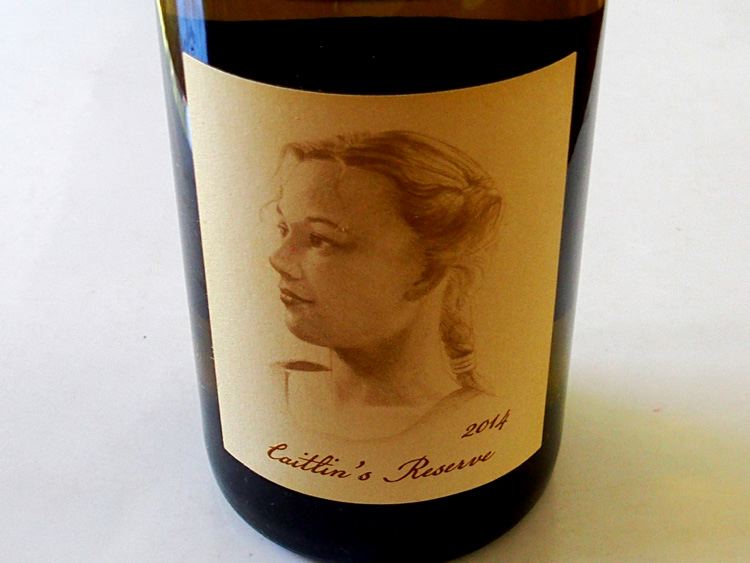 2014 Adelsheim Vineyard Caitlin’s Reserve Willamette Valley Chardonnay 13.5% alc., pH 3.32, 580 cases, $45. A LIVE certified sustainable wine composed of the finest lots of Chardonnay in the cellar. Sourced from Stoller Vineyard (63%), Nicholas Vineyard (24%) and Boulder Bluff Vineyard (13%). Dijon clones. Whole cluster pressed with a gentle bladder press, barrel fermented and aged in French oak barrels (25% new). · Light golden yellow color and clear in the glass. A delightful wine with a vibrant structure and expressive fruit, offering aromas and flavors of lemon, yellow apple, pineapple and grapefruit augmented with a gentle touch of oak. Very classy, with inviting balance and some length on the cleansing finish. Score: 92
2014 Alloro Estate Chehalem Mountains Oregon Chardonnay 13.4% alc., 250 cases, $34. Released November 2015. 100% Alloro Vineyard. Dijon clones 76 and 96. Gently whole cluster pressed, barrel fermented with 100% malolactic fermentation and lees stirring. Aged 10 months in French oak barrels, 20% new. · Moderately light golden yellow color and clear in the glass. Reserved, but pleasing aromas of lemon creme, nectarine and croissant. Silky on the palate, with inviting flavors of lemon, pineapple, brioche, creme caramel and nutty oak. Nothing but good things to say about this harmonious offering. Score: 91
2012 Amalie Robert Heirloom Cameo Willamette Valley Chardonnay 13.8% alc., 70 cases, $50. Estate grown from a 30-acre vineyard located just outside of Dalla. Dijon clones fermented in 500-liter puncheons, partial malolactic fermentation, and aged 14 months with lees stirring in French oak barrels. · Moderate golden yellow color in the glass. The nose is alerted to aromas of baked apple, spice, splintered oak and leafy herbs. On the rich and ripe side, with good depth, blessed with flavors of yellow peach, yellow apple, poached pear, and lemon in a balanced style that has begun to take on some tertiary characters with age. Score: 89
2014 Anam Cara Cellars Nicholas Estate Reserve Chehalem Mountains Oregon Chardonnay 13.2% alc., $32, screwcap. Dijon clones from 2 acres. Fermented and aged 10 months in neutral French oak barrels with a small steel tank addition. · Moderately light golden yellow color and clear in the glass. Aromas of lemon, honey and subtle bruised apple lead off. Acidity plays a bigger role than fruit in this wine with flavors of yellow stone fruits and citrus. I wanted more fruit generosity in the mid palate and finish, but the overall impression was very conducive and easy to cozy up to. Score: 88
2013 Beaux Frères Yamhill-Carlton Oregon Chardonnay 12.8% alc., 263 cases, $75. 100% Gran Moraine Vineyard planted in 2005 in Willakenzie soils. Unfined and unfiltered. · Moderately light golden yellow color and clear in the glass. Inviting aromas of lemon, pear, honey and roasted nuts. Demure, clean and bright, with juicy flavors of lemon, white peach and vanilla. Quite focused and harmonious, with well integrated acidity and a pleasingly succulent citrus-fueled finish. Score: 92
2014 Cameron Dundee Hills Oregon Chardonnay 12.9% alc., $19.50. A barrel fermented wine that is a blend of grapes from Clos Electrique and Abbey Ridge vineyards. · Moderately light golden yellow color and clear in the glass. Aromas of crusty lemon pie, lime peel and lees lead off. Smooth and slightly viscous in the mouth, with attractive flavors of lemon and green apple with very little oak in put. The flavors sneak up rather than shout out in this pleasant drink that is nicely balanced. Score: 89
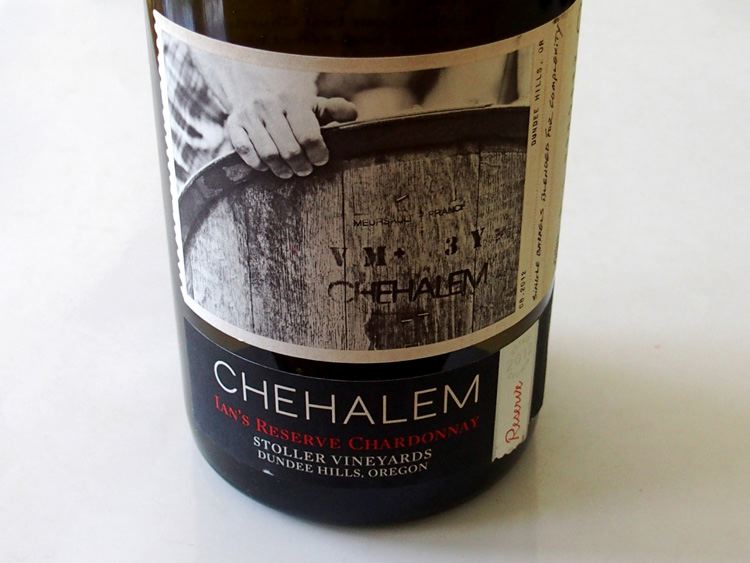 2013 Chehalem Ian’s Reserve Willamette Valley Chardonnay 12.0% alc., , $40, screwcap. A reserve barrel selection of wines from Stoller and Corral Creek vineyards. Dijon clones. Aged in 31% new and 26% onceused French oak barrels. · Moderate golden yellow color in the glass. Nicely appointed with aromas of ripe pear, lemon curd and custard. Satiny smooth in texture, with robust flavors of lemon, brioche and crème brûlée. Admirable balance and some length on the crisp, stone-ground and citrus-driven finish. Score: 92
2012 Chehalem Ian’s Reserve Stoller Vineyard Dundee Hills Oregon Chardonnay 13.9% alc., $40, screwcap. Dijon clones. Aged in French oak barrels, 34% new and 33% once-used. · Moderately light golden yellow color and clear in the glass. Complex aromas of lemon custard, crusty apple pie and spice along with a hint of reduction lead off. Nicely composed, strutting a clean and bright personality that is full of sunlight, with flavors of lemon, green apple, baked pear, caramel and toasty brioche, finishing on a soprano note with lemonlime acidity. Score: 92
2014 Cristom Eola-Amity Hills Estate Chardonnay 14.0% alc., 75 cases, $40, glass stopper. From a 0.5-acre site of the estate plantings first established in 1993. Barrel fermented and aged on the lees. · Light golden yellow color and clear in the glass. This wine seems flawed with bruised apple notes on both the nose and palate. Flavors of Golden Delicious apple, grilled peach, and subtle brioche are presented in sync with a slightly creamy texture and integrated acidity. Unique, but not in a good way. Tasted twice. Score: 85
2013 DION Estate Limited Release Chehalem Mountains Oregon Chardonnay 12.3% alc., 90 cases, $25. Harvest Brix 20.1º. Grapes were picked after the September rain downpour. Barrel fermented and aged in both barrel (20% new French oak) and stainless with lees stirring. Full malolactic fermentation. · Moderate golden yellow color and clear in the glass. Awkward aromas of bruised apple, medicine cabinet and brioche. On the silky palate, the wine is bright with acidic verve which carries over on the tart finish. The core flavor is Granny Smith apple in a lightly weighted style. Under ripe with teeth etching acidity. Score: 85
2013 Domaine Serene Côte Sud Dundee Hills Oregon Chardonnay 13.3% alc., 155 cases, $75. Estate grown, produced and bottled. Grapes are from a nearly 6-acre, dry-farmed vineyard located at 600 to 680 feet elevation. Dijon clones closely planted in Jory soil. Fermented and aged on the lees in French oak barrels. Last tasted March 2016. · Moderate golden yellow color and clear in the glass. Pleasing aromas arrive slowly with time in the glass, revealing scents of lemon, white peach, apple, and iron-rich earth. Discreet richness on the palate, with vibrant flavors of white and yellow stone fruits and lemon. Slightly oily in texture and polished in demeanor with a gorgeous, cleansing finish with some staying power. Score: 93
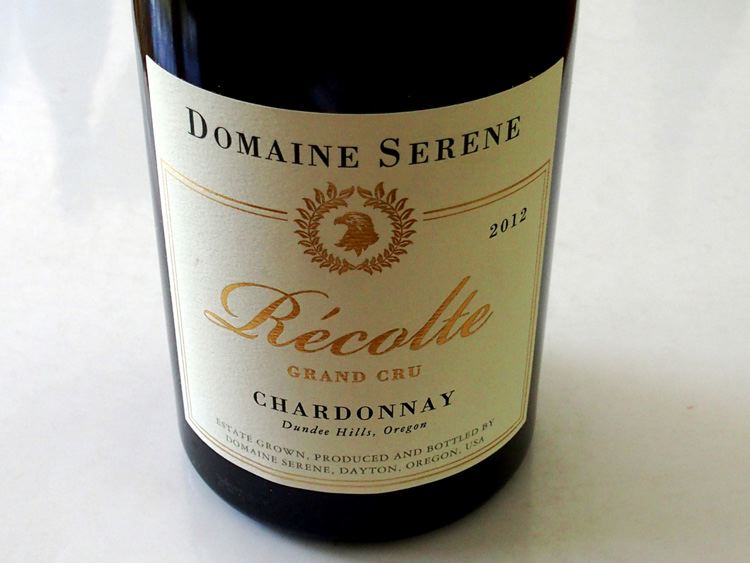 2012 Domaine Serene Récolte Grand Cru Dundee Hills Oregon Chardonnay 14.2% alc., 144 cases, $125. Estate grown, produced and bottled. Composed of barrels from finest Domaine Serene Estate fruit. Dijon clones planted in Jory soil, dry-farmed, high-elevation vineyards. The pinnacle of the winery’s Chardonnay program. Last tasted in March 2016 with consistent results. · Moderate golden yellow color and clear in the glass. A serious and hi-collar offering that leads with aromas of lemon oil, nectarine, garrigue and chalk dust. Satiny smooth in texture, impeccably crafted, and highly focused, with flavors of lemon pie, grapefruit, and a compliment of toasty oak. This wine can be enjoyed now, but its balance predicts long term aging that will most certainly reward the drinker. Score: 94
2014 Durant Vineyards Lark Dundee Hills Oregon Chardonnay 13.9% alc., pH 3.57, 350 cases, $28. Clone 96 planted in 1993. Harvest Brix 23.4º. Yields 4+ tons per acre. · Light golden yellow color and clear in the glass. The nose is fruit shy, offering aromas of brioche and green oak. Soft and slightly creamy on the palate, offering integrated modest acidity, and lightly flavored notes of citrus, peach, and honeydew melon. Score: 87
2014 Eola Hills Oregon Chardonnay 12.5% alc., pH 3.23, TA 0.55, RS 6 gm/L, 3,718 cases, $13. Sourced from vineyards throughout Oregon. Harvest Brix 19.2º-24.3º. Fermented and aged in oak for 8 months. · Moderately light golden yellow color and clear in the glass. Like able aromas of lemon, mango and white flower lead to pleasing flavors of lemon, baked apple, brioche, creme caramel, toast and vanilla. The acidity is nicely integrated in this easy to like wine. Score: 88
2014 Evesham Wood Willamette Valley Oregon Chardonnay 12.5% alc., $14, screwcap. Unfiltered. · Light golden yellow color and clear in the glass. Aromas of citrus, saline, nori and flint lead to a crisp core of lemonlime fruits accented with notes of nori and pungent floral fragrances. Smooth in the mouth, with a lip-smacking, soprano finish. Score: 88
2013 Goodfellow Family Cellars Whistling Ridge Vineyard Ribbon Ridge Oregon Chardonnay 13.5% alc., 220 cases, $N/A. From a 14-acre dry farmed vineyard planted in 1990 in Willakenzie soil. · Light golden yellow color and clear in the glass. Aromas arrive and depart over time, showing lemon-lime, green grass, brioche, toast and a hint of petrol. Soft and smooth on the palate with lemon-lime, peach, and vanilla flavors underlain with brisk acidity that confers a cleansing sensation on the finish. Score: 88
2014 Knudsen Vineyards Dundee Hills Willamette Valley Chardonnay 13.5% alc., pH 3.27, TA 0.63, 275 cases, $45, screwcap. Vineyard is home to oldest plantings of Dijon clones in Willamette Valley (1990). A blend of clones 76 and 95 planted in Jory soil in 1995. Aged 6 months in French oak barrels, 20% new. Last tasted in March 2016. · Light golden yellow color and clear in the glass. Lovely aromas of lemon, grapefruit, green apple and white flower. Soft in the mouth, with the full display of citrus fruits as well as notes of apple, spice and honey. Bright and crisp, with a wave of citrus returning at the end. Score: 94
2014 Longplay “Jory Slope” Lia’s Vineyard Chehalem Mountains Oregon Chardonnay 13.0% alc., 44 cases, $32. Jay Somers winemaker and Todd Hansen grower. · Light golden yellow color and clear in the glass. Faint lemon aromas are accented with a touch of hazelnut and white flower. Apple-driven on the palate with added notes of white peach and nutty oak in the background. Smooth and pristine, with balanced acidity. Score: 89
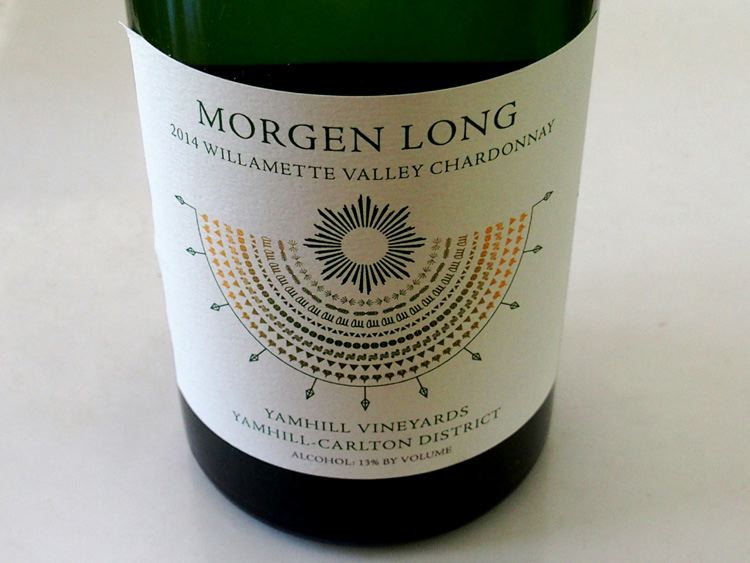 2014 Morgen Long Yamhill Vineyards Yamhill-Carlton District Willamette Valley Chardonnay 13.0% alc., $49. This wine is crafted by Seth Morgen Long, a Portland-based wine broker and Chardonnay winemaker. · Light golden yellow color and clear in the glass. Nicely perfumed with striking aromas of lemon drop, white peach and subtle nutty oak. Satiny smooth, with high brow flavors of lemon, white stone fruits and vanilla creme. Adeptly fashioned and pleasing from the entry to juicy finish. Score: 91
2012 Ponzi Vineyards Reserve Willamette Valley Chardonnay 13.8% alc., $32. A blend of Dijon clones grown primarily on Laurelwood soils. · Light golden yellow color and clear in the glass. Aromas of forest path, nutty oak and flint. A simple wine with a soft mouthfeel and pleasing citrus flavors backed by prevalent nutty oak. The slippery finish has more citrus-fueled intensity than the entry. A sulfur note rises up on the finish. Score: 86
2014 RoseRock Drouhin Roserock Vineyard Eola-Amity Hills Oregon Chardonnay 14.1% alc., $33. LIVE certified sustainable vineyard farmed by Philippe Drouhin. Volcanic soils. Whole cluster pressed with equal parts sent to tank and barrel. Once malolactic fermentation was completed, winemaker Veronique Drouhin assembled the two portions into the final cuvée. · Light golden yellow color and clear in the glass. Very shy aromas of wet stones, lemon oil and honeysuckle. Flavorful, with tastes of lemon, caramel and brioche in a fairly simply styled wine with bright acidity and welcome crispness. Score: 87
2012 Tendril White Label Willamette Valley Oregon Chardonnay 13.5% alc., $40. Crafted by noted winemaker Tony Rynders. 62% Yamhill-CArlton and 38% Chehalem Mountains. Aged 15 months in French oak barrels, 30% new. · Moderately light golden yellow color and clear in the glass. Leading off are aromas of grilled lemon, green apple, spice and talc. Sound acidity and silky texture make this a highly enjoyable wine that features flavors of lemon curd, caramel and slight butterscotch. There is definitely evidence of fermentation and aging in oak, but the effect is complimentary rather than intrusive. Score: 90
2014 WildAire Open Claim Vineyard Willamette Valley Chardonnay 14.1% alc., 137 cases, $35. Whole cluster pressed, fermented and aged on the lees in French oak barrels, 16% new. · Light golden yellow color and clear in the glass. Extremely shy nose that resists exposing itself despite vigorous swirling over time. Much more expressive on the palate with tastes of Golden Delicious apple and toasty brioche. Satiny smooth in the mouth with juicy acidity and a clean finish. Score: 88
2014 Walter Scott Freedom Hill Vineyard Willamette Valley Oregon Chardonnay 13.2% alc., pH 3.21, 100 cases, $45 (sold out). Dijon clone 95. Inaugural wine from this vineyard. Native fermentation. Fermented and aged in a new puncheon and four neutral barrels for 11 months, finished in stainless steel for three months. · Light golden yellow color and clear in the glass. Aromas of wet stones, graphite, lemon waver, vanilla and slight nutty oak. Slightly viscous and moderately weighty, with flavors of lemon and baked pear, finishing with good cut and a little salinity. Score: 93
2014 Walter Scott X Novo Vineyard Eola-Amity Hills Oregon Chardonnay 13.45% alc., pH 3.24, 150 cases, $45 (sold out). Close to 15 different clones. Native fermentation. Fermented and aged in a new puncheon, second fill puncheon, and a few neutral oak barrels for 11 months, finished in stainless steel for three months. · Light golden yellow color and clear. Very appealing aromas of lemon oil, apple, brioche, pain grille and the slightest flint. Sleek and balanced on the palate, with impressive focus and crispness, featuring flavors of citrus, yellow apple, yellow peach, subtle nutty oak, and garrigue. The fruit saturates the mid palate and really hangs on through the clean finish. Score: 94
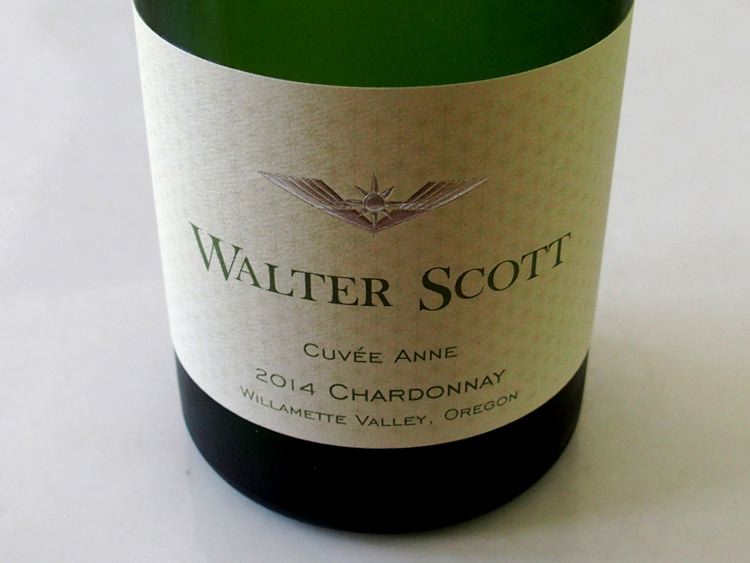 2014 Walter Scott Cuvée Anne Willamette Valley Oregon Chardonnay 13.25% alc., pH 3.24, 250 cases, $40 (sold out). Mostly Dijon 76 and 95 with 30% X Novo blend of clones. · Light golden yellow color and clear in the glass. Wonderful aromas of fresh lemon, white peach, and complimentary brioche and nutty oak. Delicious and vivacious flavors of lemon curd, pear, honeycomb, and toffee. The mouthfeel is satiny smooth in this wine of immense charm that offers a vivid infusion of flavors on the attack and mid palate, carrying through to a vibrant finish that urges another sip. This is a shining example of Oregon’s potential for Chardonnay. Score: 95
2013 Winderlea Vineyards & Winery Willamette Valley Oregon Chardonnay 13.5% alc., 525 cases, $38. Sourced from Carabella Vineyard (43%), Hyland Vineyard (37%) and Thistle Vineyard (18%). Dijon 76 and 95, California 108 and 04. Aged 10 months in French oak, 17% new. · Moderately light golden yellow color in the glass. Shy but pleasant aromas of spiced apple, lemon creme and vanilla. Crisp, clean and sleek, with flavors of lemon and yellow apple, finishing with a tight cut of citrus-fueled acidity. Score: 91
1989 The Eyrie Vineyards Estate Grown Reserve Yamhill County Willamette Valley Chardonnay 12.5% alc.. · Moderate apricot color and clear in the glass. This aged wine leads with aromas of peach pit, Nutella, buttered toast and nuts. Smooth and balanced, with clean flavors of nectarine and other stone fruits, grilled grapefruit and caramel. Still quite enjoyable, with a nutty, slightly sherry toned finish.
 2002 The Eyrie Vineyards Estate Grown Willamette Valley Oregon Chardonnay 13.0% alc.. · My notes on this wine fill an entire page but I will summarize here. Moderately dark butterscotch yellow color and clear in the glass. Engaging aromas of butterscotch, buttery brioche, toast, grilled peach and vanilla. An amazing array of intense flavors meet the palate with tastes of lemon, white peach, hazelnut, apricot, nectarine, and creme caramel. Surprisingly fresh and vibrant with an old Chardonnay veneer that astounds. Silky smooth in texture, with seamless pride, and a lip-smacking finish. I stuck it in the refrigerator after tasting and revisited it the following day. The nose was a little more funky, but oh my, the palate was still stellar and my wife and I finished the bottle with a big smile. This may be the greatest old domestic Chardonnay I have ever tasted. Honestly, I liked this wine more than any of the other more recent Oregon Chardonnay offerings reviewed in this article!
Recently Tasted Oregon Pinot NoirMost of the wines reviewed here are from the 2013 and 2014 vintages. These were contrasting years, with 2013 being more challenging because of drenching rains in late September. 2014 will go down as the warmest growing season in recorded history in the Willamette Valley, with moderate temperatures throughout the growing season well into mid-October. As a result, the 2014 Pinot Noirs are generally riper, more sappy wines with lower acidities, while the 2013 Pinot Noirs are more typical of what we have come to expect from the Willamette Valley with more vibrancy, less extraction and lower alcohols. Yields were noticeably higher in 2014 than 2013. There are still some stellar wines available as well from the glorious 2012 vintage.
Alloro Vineyard, SherwoodLocated on a southwest-facing slope in Oregon’s Chehalem Mountains AVA, this 78-acre vineyard site is personally cared for by founder David Nemarnik. Wines are limited production and 100% Estate from a LIVE and IOBC Certified Sustainable vineyard. Pinot Noir blocks are composed of Dijon clones 777, 667, 114 and 115 along with Pommard clone planted in Laurelwood series soils. Winemaker and General Manager Tom Fitzpatrick is Burgundy trained and educated at the University of California at Davis. His focus is on “elegantly composed, terroir driven wines.” The tasting room is open Thursday through Monday year round. Visit www.allorovineyard.com. The Pinot Noirs are 100% de-stemmed, undergo no cold soak, are inoculated for a warm primary fermentation, followed by native malolactic fermentation in barrel, and aged 10 months in French oak barrels. Most of the Pinot Noir was picked before the torrent of rain than came in 2013 the last week of September.
2013 Alloro Estate Chehalem Mountains Oregon Pinot Noir 13.4% alc., 1,300 cases, $35. Release September 1, 2016. 100% Alloro Vineyard. 41% Pommard, 30% 777 and 29% 114. Aged in 24% new French oak barrels. · Moderately light reddish purple color in the glass. The nose blends aromas of cherry and nutty oak, showing more oak over time in the glass. Light to mid weight in style with a toned cherry core supported by silky tannins and complimentary oak. Easy to drink, with some length to the sweet cherry finish. Score: 89
2013 Alloro Estate “Riservata” Chehalem Mountains Oregon Pinot Noir 13.5% alc., 300 cases, $45. Release September 1, 2016. 100% Alloro Vineyard. 28% Pommard, 53% 777 and 19% 114. Aged in 41% new French oak barrels. · Moderate reddish purple color in the glass. Clearly a step up in quality with a more aromatic nose offering scents of ripe dark cherry and a hint of toasty oak. Discreetly concentrated with pleasing flavors of dark cherry and blueberry framed by structured but blended tannins. Softly textured and seductive, with a deft touch of oak. Score: 91
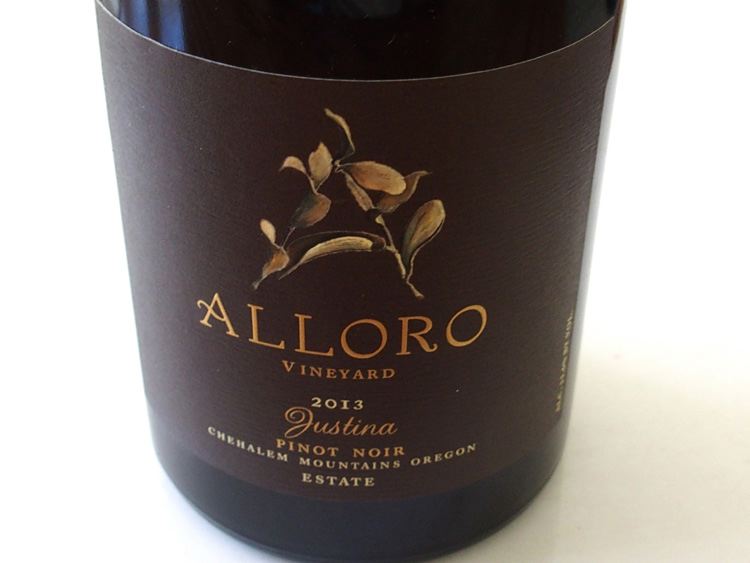 2013 Alloro Estate “Justina” Chehalem Mountains Oregon Pinot Noir 13.6% alc., 100 cases, $85. Release September 1, 2016. 100% Alloro Vineyard. 100% Dijon 777. Aged in 71% new French oak barrels. · Moderately dark reddish purple color in the glass. Brooding aromas of darker stone and berry fruits, opening slowly in the glass. The wine has a strong physique and notable oak presence, with a core of black cherry and raspberry fruit and mildly firm but silky tannins. Creamy in the mouth with a compliment of oak toast and spice. Much more open and enjoyable several hours later when tasted from a previously opened and re-corked bottle with the fruit more exuberant as it escaped some of its oak cloak. A serious offering that is age worthy. Score: 93
ÉLEVÉE Winegrowers, DundeeÉLEVÉE Winegrowers grow wines from diverse sites in Oregon’s Willamette Valley. In 2008, after years of professionally growing and crafting wines for others, winemaker Tom Fitzpatrick was presented with an opportunity when Archery Summit’s Gary Andrus decided to sell a very special, high density microsite with volcanic Jory soils in the Dundee Hills. Andrus had planted the vineyard in 1998. Tom and France Fitzpatrick bought the vineyard and named it ÉLEVÉE Vineyard. This LIVE and IOBC Certified Sustainable vineyard is personally farmed by the proprietors and each year a single wine is crafted from this site to show the elegant and seductive personality of this vineyard. In 2016, two more sites were acquired: an Eola-Amity Hills site with volcanic Nekia soils and a Chehalem Mountains site with Laurelwood soils. Visit www.eleveewines.com.
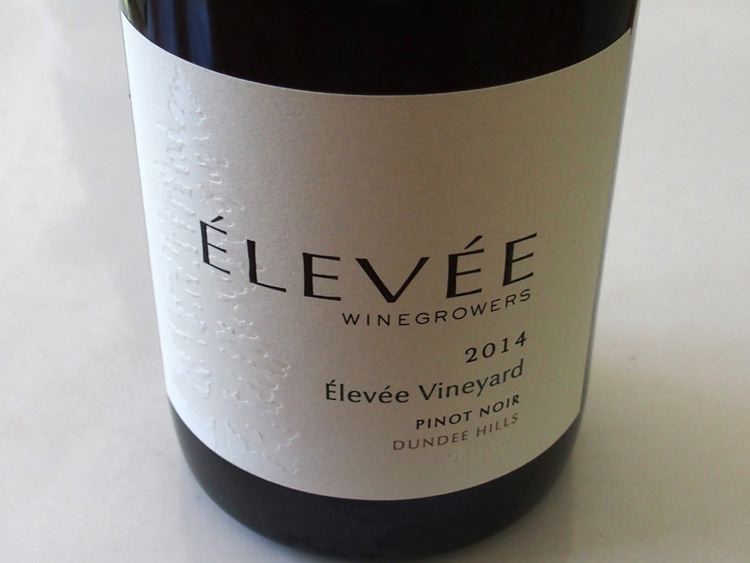 2014 ÉLEVÉE Winegrowers ÉLEVÉE Vineyard Dundee Hills Oregon Pinot Noir 13.9% alc., 300 cases, $48. Release August 1, 2016. 50% Dijon 777 and 50% Dijon 115. 100% de-stemmed, 80-day cold soak, native inoculum, aged 11 months in French oak barrels, 33% new. · Moderately light reddish purple color in the glass. The nose is highly inviting, with soaring aromas of cherry, rose petal and spice. Lighter in style and elegant, but plenty of weighty red cherry and red raspberry flavors framed by juicy acidity and silky tannins. The wine is seamless, with an engaging mouthfeel and an intriguing bit of iron minerality. Score: 92
Benton-Lane Winery, MonroeLifelong winemakers Steve and Carol Girard founded this winery. High school sweethearts whose families loved wine, they began their wine journey in the Napa Valley where they established their first winery together, Girard Winery. They soon developed a passion for Pinot Noir and began searching the world for a Pinot Noir vineyard. They found Sunnymount Ranch in the foothills of the Willamette Valley Coast Range near the village of Monroe. The Girards bought the 1,860-acre property in 1988 and began the planting of Pinot Noir the following year. The first Benton-Lane wine was produced in 1992. A winery was built in 1997 and the vineyard has grown to 142 acres of Pinot Noir, Pinot Blanc and Chardonnay. Benton-Lane wines are made from 100% estate grown grapes. Since 2005, Benton-Lane has received more Top 100 Wines of the Year for still wines than any other Oregon winery. Check the website at www.benton-lane.com for tasting room hours.
2013 Benton-Lane Estate Grown Willamette Valley Oregon Pinot Noir 13.4% alc., $25, screwcap. · Moderately light reddish purple color in the glass. Aromas of cherry, earthy flora and woodpile are underlain with a hint of matchstick reduction. Light to mid weight red cherry and berry fruits satisfy in this simple and forward wine that has a modest and grippy finish. The tannins are silky, making for easy enjoyment, but the mid palate is a bit shallow and the oak overlay sticks out. Score: 87
2012 Benton-Lane First Class Estate Grown Willamette Valley Oregon Pinot Noir 14.1% alc., $65, screwcap. · Moderate reddish purple color in the glass. Deep aromas of black cherry, black raspberry and blueberry-pomegranate. Nicely endowed with luscious, ultra ripe black cherry and blackberry fruit flavors accented with a hint of bourbon and spice. This wine packs plenty of power but is still refined in character, with a balancing vibrancy due to crisp acidity. The cleansing and intensely fruited finish leaves behind a pleasing impression. Score: 91
DION Vineyard, CorneliusThis vineyard has been run by the Johnson family for three generations for more than 30 years. Grapes are sold to multiple wineries throughout Oregon and small quantities of estate grown wine are produced under the DION label. The 60-acre vineyard is located in the Chehalem Mountains AVA the Northern Willamette Valley. The Pinot Noir, Pinot Gris and Chardonnay vines (some of which date to 1976) are rooted in Laurelwood soils at elevations of 300 to 500 feet. The winery tasting room is open Saturday and Sunday from April to November. Visit www.dionvineyards.com.
2014 DION Vineyard Chehalem Mountains Oregon Pinot Noir 13.8% alc., 240 cases, $25. Harvest Brix 23.6º-24.4º. Clones are 115, 114 and Pommard from vines between 13 and 36 years of age. Short cold soaks, many fermentations started naturally, on the skins 7-10 days. The wine was barrel aged for 10 months in French oak barrels, 25% new. · Light cherry red color in the glass. Heady aromas of cherry, pomegranate and the slightest oak. A joy to drink, with an aggressive attack of black cherry fruit, persisting through a lovely cherry-fueled finish. A little spice adds interest, the acidity is fully integrated, and the overall impression is one of harmony and poise. Score: 91
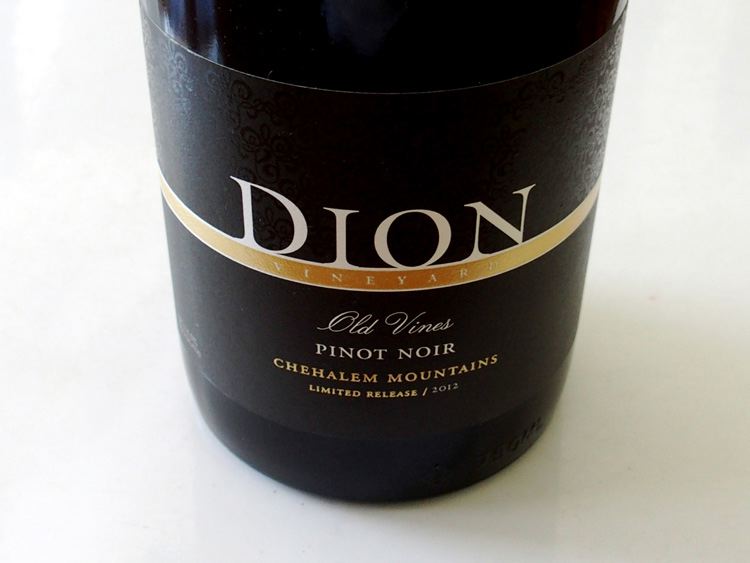 2012 DION Vineyard Old Vines Chehalem Mountains Oregon Pinot Noir 14.5% alc., 50 cases, $45. Pommard clone. Harvest Brix 25.0º. This wine is from the original block of selfrooted vines dating to 1976 and is the flagship bottling from this vineyard. Aged 13 months in French oak barrels, 50% new. · Moderately light cherry red color in the glass. The aromatics are so engaging I was satisfied just to inhale the perfume. Aromas of fresh cherry and wine cellar lead to a mid palate explosion of black cherry goodness that alerts the senses. A bit of complimentary smoke and anise plays in the background. Polished and velvety in the mouth, with balanced tannins and a sleek, lingering finish. This beauty is old vine Pinot poetry. Score: 94
Franchere Wine Co., WoodburnMike Hinds, owner and winemaker, is the great-great-great grandson of Gabriel Franchère, a native of Montreal who explored Oregon for three years beginning in 1811. Mike developed an obsession with wine as a young man, and after working in wine shops in Chicago, Illinois, returned to Oregon to begin winemaking and viticulture classes. He became a cellar worker at Illahe Vineyards, the winery where he began making the Franchere wines in 2013. Mike’s wines are sourced from sustainable, dry farmed vineyards. No new oak, no adjuncts, no tannin or enzyme additions, no temperature control, no fining or filtering of Pinot Noir. Visit www.francherewine.com.
2014 Franchere Eola-Amity Hills Oregon Pinot Noir 13.4% alc., pH 3.54, TA 0.61, 150 cases, $24. Release September 2016. Sourced from Zenith Vineyard (83%, Harvest Brix 23.4º) and Zena Springs Vineyard (17%, Harvest Brix 22.1º). 100% de-stemmed, no cold soak, spontaneous native yeast fermentation, 1g/L tartaric acid addition, aged 10 months in used oak barrels. Bottled with Diam closure unfined and unfiltered. · Moderate reddish purple color in the glass. The nose offers a strange mix of aromas including muddled black cherry, hops, bruised apple and Beaujolais nouveau. Light to mid weight in style, soft in the mouth, with simple flavors of black cherry and dark red berries energized with a lively acid spine, balanced tannins, and a modest finish. Score: 85
2014 Franchere Zena Springs Vineyard Eola-Amity Hills Oregon Pinot Noir 12.6% alc., pH 3.67, TA 0.63, 48 cases, $28. Release September 2016. Harvest Brix 22.1º. Native yeast ferment, 0.5 g/L tartaric acid addition, aged 15 months in used French oak barrels. Bottled with Diam closure unfined and unfiltered. · Moderately dark reddish purple color in the glass. Deep aromas of black fruits, forest path and white pepper. The exuberant, sweet, and sappy flavors of blackberry and cassis are overwhelmed by muscular, drying tannins that ply the finish with a vengeance. Better the following day from a previously opened and re-corked bottle when the tannins had ameliorated some but this will always be a tannic wine. Best to decant this wine if drunk now. Score: 87
2014 Franchere Zenith Vineyard Eola-Amity Hills Oregon Pinot Noir 13.9% alc., 70 cases, $34. Release September 2016. Native ferment, addition of 1 g/L tartaric acid, aged in used French oak barrels for 15 months and bottled with Diam closure unfined and unfiltered. · Moderately dark reddish purple color in the glass. Shy aromas of black fruits, cassis, black grape syrup and a hint of bruised apple. The mid weight plus core of black cherry and black raspberry fruits are nicely spiced and charming. The mouthfeel is silky and the tannins, although evident, are nicely integrated and do not haunt the enjoyable, purple-fruited finish. Score: 88
Ghost Hill Cellars, CarltonFor over 100 years, the Bayliss family has farmed 230 acres on Savannah Ridge in what is now the Yamhill- Carlton AVA. The Bayliss-Bower Vineyard was planted to 15 acres of Pinot Noir in 1999, and the first Ghost Hill Cellars wine was released in 2006. The vineyard is planted to Pommard, Wädenswil, and Dijon 777, 114 and 115 clones. Ghost Hill Cellars is LIVE certified and Salmon-Safe. The winemaker is noted Oregon veteran Eric Hammacher. A quaint tasting room, modeled after a prospector’s shack, and built by owner Mike Bayliss and son Michael, is open seasonally Friday-Sunday 12:00 p.m. to 5.00 p.m.
2014 Ghost Hill Cellars Bayliss-Bower Vineyard Yamhill-Carlton Oregon Pinot Noir Blanc 13.5% alc., pH 3.49, 590 cases, $25, screwcap. Whole cluster pressed and settled in stainless tank. The juice was racked off heavy sediment and fermented in a second stainless tank to dryness. The wine was aged in stainless on the lees with frequent stirring. · Light pink color in the glass. Elevating aromas of strawberry, white peach and watermelon lead to a bright and vibrant wine that is light on its feet, featuring flavors that echo the nose. An outstanding example of this Pinot Noir curiosity and one of Oregon’s best examples. Serve chilled as a superb accompaniment to summer barbecues. Score: 90
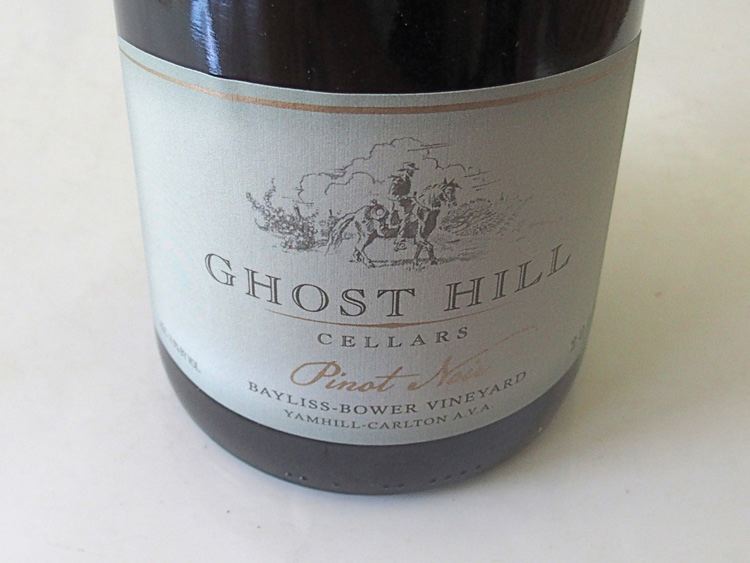 2013 Ghost Hill Cellars Bayliss-Bower Vineyard Yamhill-Carlton Oregon Pinot Noir 13.5% alc., pH 3.80, 331 cases, $42. A blend of four clones including Pommard (45%), 777 (20%), 114 (20%) and 15% Wädenswil. Aged in French oak barrels, 10% new. · Light cherry red color in the glass. I loved the nose which offered waves of cherry, baking spice and sandalwood aromas. Soft in the mouth and easy to indulge, with mid weight flavors of cherry, spice and a hint of herbal oak, framed by balanced, chalky tannins. An impressive offering from the difficult 2013 vintage. Score: 92
Luminous Hills, DundeeLuminous Hills is a highly photogenic 12-acre vineyard located in the Yamhill-Carlton District owned and farmed by Byron and Dana Dooley who also produce Pinot Noir under the Seven of Hearts label. Clones 115, 667, 777 and Pommard are planted to match both Jory volcanic and sedimentary soils. The non-irrigated vineyard is certified LIVE and Salmon Safe. Three wines are produced from this site: an estate bottling, a LUX bottling representing a special selection of barrels combining Pommard and 777 clones, and a bottling named ASTRA that is primarily whole cluster fermented. The inaugural vintage from this vineyard was 2008. The winery’s tasting room is located in Carlton. Visit www.luminoushills.com.
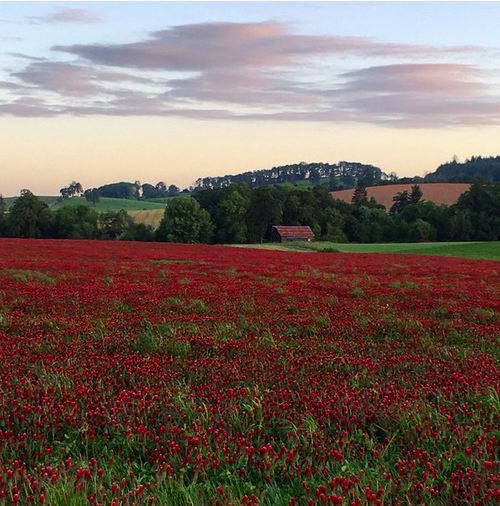
2014 Luminous Hills Estate Yamhill-Carlton Oregon Pinot Noir 13.3% alc., pH 3.59, TA 0.60, 421 cases, $35. Clones 115, 667, 777 and Pommard from six blocks, volcanic and sedimentary soils. Aged in French oak barrels, 23.5% new. · Moderately light cherry red color in the glass. Shy aromas of oak-kissed fruit lead off. The mid weight black cherry and blueberry flavors are long in the mouth as well as persistent on the cleansing finish. Silky in texture, the wine has some lingering oak influence that should subside with more time in bottle. Score: 90
2014 Luminous Hills Estate LUX Yamhill-Carlton Oregon Pinot Noir 13.5% alc.,pH 3.58, TA 0.57, 149 cases, $42. 67% Pommard (sedimentary soil) and 33% 777 (volcanic soil). Aged in French oak barrels, 16.7% new. · Moderately light reddish purple color in the glass. The nose is quite earthy, with aromas of sod and mulch complimenting the smell of purple grapes and boysenberries. A bolder, stylish offering, showing an intense attack of black cherry and boysenberry flavors framed by firm but balanced tannins, and finishing long with a generous wave of juicy fruit embellished with a touch of oak. Score: 91
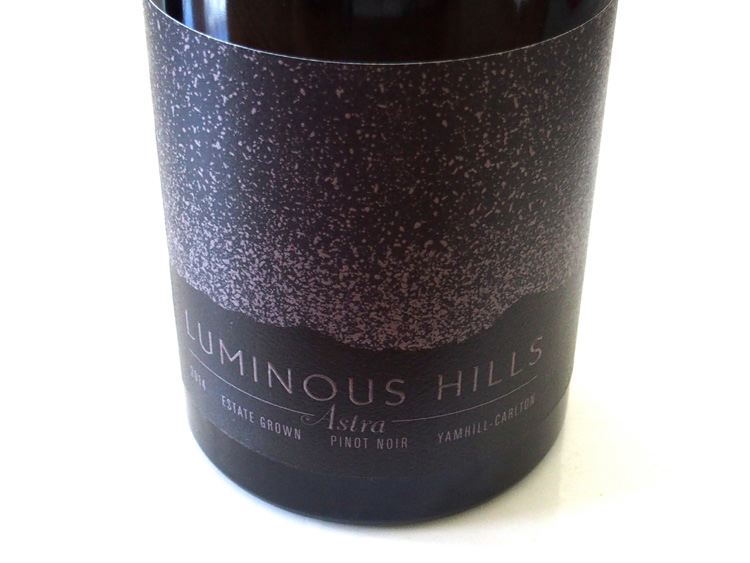 2014 Luminous Hills Estate ASTRA Yamhill-Carlton Oregon Pinot Noir 13.1% alc., pH 3.55, TA 0.61, 123 cases, $42. Clones are 667 (40%, volcanic soil) and 115 (60%, sedimentary soil). Aged in French oak barrels, 40% new. · Moderately light reddish purple color in the glass. The nose is reticent upon opening, offering slow evolving aromas of black cherry, cowhide and mulch. Noticeably vibrant, featuring light to mid weight flavors of dark red and purple fruits encased in silky tannins. Inviting harmony and refinement, with a very special finish rendering delicious spiced cherry goodness. Score: 92
Rain Dance Vineyards, NewbergFifth generation Newberg resident Ken Austin III and his spouse, Celia, planted the first vines on their estate in the Chehalem Mountains in 2008, a few months after the Austin family began building the Allison Inn & Spa. The 15-acre Rain Dance Vineyard is planted to Pommard, Wädenswil, and Dijon clones 115, 667, 777 and 943 in Jory soil. Today Rain Dance Vineyards owns seven estate vineyard sites totaling 120 acres, 59 of which are currently planted. All vineyards are dry farmed using sustainable practices and are Salmon Safe and LIVE certified. The Austins had previously established Rain Dance Ranch in 1991 that became one of the country’s premier llama ranches and llamas are a prominent fixture on the hillside of Bell & Herd Roads in Newberg. The first Estate Pinot Noir from the 2013 vintage was released May 1, 2015, crafted by winemaker Bryan Weil who has winemaking experience at Domaine Serene, Tyee Wine Cellars, and Alexana Winery, all in Oregon. The winery’s tasting room is located just off the corner of Bell Road and Highway 219 at the base of the Chehalem Mountains AVA in the Rain Dance Marketplace. A flagship Estate Pinot Noir and member exclusive Reserve Pinot Noir are offered. Tastings are available Tuesday through Sunday. Visit www.raindancevineyards.com. Prices are quite moderate considering the high quality.
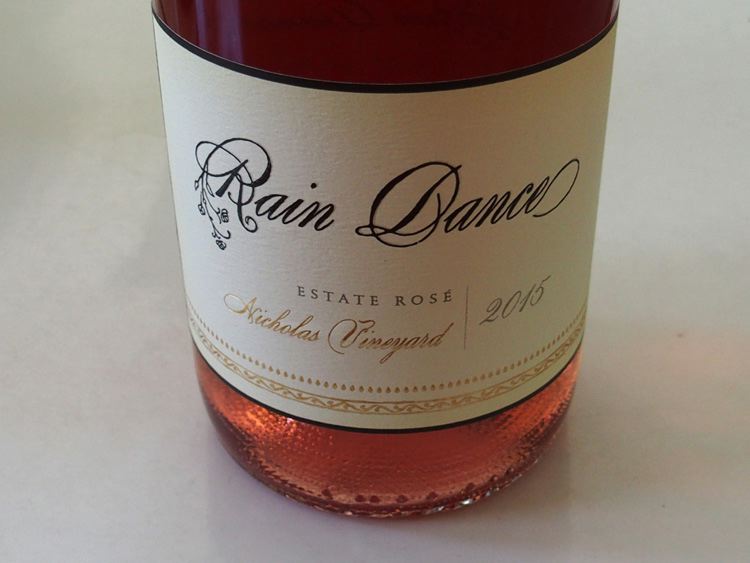 2015 Rain Dance Nicholas Vineyard Estate Chehalem Mountains Oregon Rosé 14.1% alc., pH 3.47, TA 0.56, RS 0.16%, 149 cases, $22, screwcap. Released May 1, 2016. Harvest Brix 24.2º. Whole cluster pressed, on skins 4 hours, cold fermented, and aged in neutral French oak barrels. · Moderate strawberry red color in the glass. Very fragrant, even over time in the glass, showing aromas of strawberry, raspberry, peach and blood orange. A hearty styled rosé with flavors of cherry, watermelon, strawberry and orange peel. Smooth and crisp in the mouth with some length on the fruit-filled finish. Score: 90
2013 Rain Dance Estate Chehalem Mountains Oregon Pinot Noir 12.7% alc., pH 3.84, TA 0.50, 150 cases, $40. Harvest Brix 21.5º. 67% Wädenswil, 33% Pommard. 4-day cold soak, 10-day fermentation, aged 10 months in French oak barrels, 50% new. · Moderately light reddish purple color in the glass. There is plenty of oak input on the nose, with aromas of spice, smoke and clove along with the scent of black cherry fruit. Light to mid weight in style, with a peppery, spicy cherry core. Rather delicate and elegant, with oak influence in the background, finishing demurely. Score: 88
2014 Rain Dance Estate Chehalem Mountains Oregon Pinot Noir 13.5% alc., pH 3.74, TA 0.47, 150 cases, $40. Released May 1, 2016. Harvest Brix 24.8º. 57% Pommard, 28% Wädenswil, 14% 667. 4-day cold soak, 10-day fermentation, aged 10 months in French oak barrels, 29% new, 29% once-filled and 42% neutral. · Moderate reddish purple color in the glass. Riper nose and flavors, featuring black cherry and blueberry fruits, a note of root beer, and a thread of smoky oak in the background. Cashmere tannins lead to a velveteen mouthfeel in this soothing wine with some length on the upbeat finish. Score: 89
Seven of Hearts, DundeeThis label offers wines from distinct appellations within the Willamette Valley and neighboring regions, including specific vineyards and portions of vineyards that show unique characteristics. Seven of Hearts is about exploring vineyards other than the estate Luminous Hills Vineyard as well as other varietals. The label, with its neo-classical elements, symbolizes winemaker Byron Dooley’s passion for traditional old world style wines. Visit the website at www.sevenofheartswine.com.
2014 Seven of Hearts Willamette Valley Oregon Pinot Noir 13.2% alc., pH 3.46, TA 0.61, 987 cases, $24. Multiple appellations, multiple clones. Aged in French oak barrels, 22% new. · Moderately light reddish purple color in the glass. Ripe fruit aromas are dominated by scents of wood and brine. The mid weight core of cherry, plum, and purple berries is backed by a thread of oak. The firm but silky tannins add support and there is some modest length on the finish. Score: 87
2014 Seven of Hearts Bjornson Vineyard Eola-Amity Hills Oregon Pinot Noir 13.5% alc., pH 3.41, TA 0.61, 98 cases, $35. 25% Wädenswil, 25% Pommard, 25% 667, 12.5% 777, and 12.5% 115. 25% whole clusters. Aged 16 months in French oak barrels, 25% new. · Moderately light cherry red color in the glass. Smelling this wine felt took me to a barrel room with an added fruit note of cherry and brown spice. Somewhat demure, but flavorful, featuring juicy red cherry and strawberry fruits with spice in the background. Silky in the mouth and showing great harmony, this wine is very forward drinking with considerable charm. Score: 91
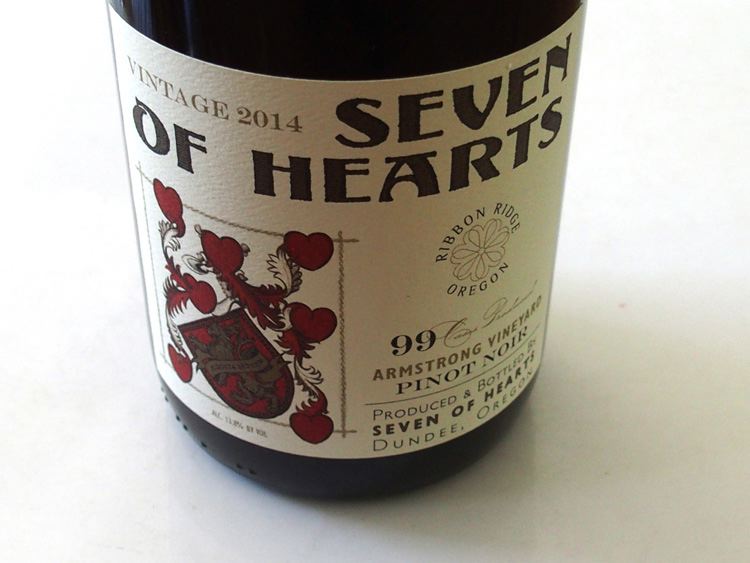 2014 Seven of Hearts Armstrong Vineyard Ribbon Ridge Oregon Pinot Noir 13.8% alc., pH3.47, TA 0.60, 99 cases, $35. 50% Wädenswil, 25% Pommard, 25% 114. 25% whole clusters. Aged 16 months in French oak barrels, 25% new. · Moderately light reddish purple color in the glass. A jazzy nose with hi-tone aromas of crushed black cherries, sous-bois and sandalwood. Bold and weighty, but still refined, with mid weight flavors of black cherry, blackberry, blueberry and spice. Exquisitely balanced t n’ a with some length on the finish. Big for Oregon, but not big by California standards. This vineyard excelled in this vintage. Score: 93
2014 Seven of Hearts Special Reserve Oregon Pinot Noir 13.8% alc., pH 3.47, TA 0.60, 124 cases, $49. 60% Armstrong Vineyard and 40% Bjornson Vineyard. 40% Pommard, 20% Wädenswil, 20% 777 and 20% 115. 20% whole clusters. Aged 16 months in French oak barrels, 40% new. · Moderately light reddish purple color in the glass. Aromas of black cherry, black plum and marionberry have a steely tone leading to a good attack of black cherry, boysenberry and plum fruits that engage the palate and linger on the intensely fruited finish. The balance is most impressive and of reserve quality, although the fruit is not as giving now as it possibly will be with more bottle age. Score: 90-91
2014 Seven of Hearts Very Special Reserve Oregon Pinot Noir 13.7% alc., pH 3.53, TA 0.68, 123 cases, $75. 40% Luminous Hills Vineyard, 20% Armstrong Vineyard, 20% Bjornson Vineyard and 20% Lia’s Vineyard. 40% 115, 30% Pommard, 20% 777 and 10% Wädenswil. 40% whole clusters. Aged 16 months in French oak barrels, 40% new. · Light cherry red color in the glass. The array of aromas are quite pleasing and persistent, consisting of cherry, strawberry, sandalwood and caramelized oak. On entry, there is more explosion of red fruit flavor than one would expect from the light color. There is plenty of spice from the whole cluster, but no herbal character. The wine is deftly balanced, with a satiny texture and the majestic finish lingers with succulent acidity. Not the biggest wine in the Seven of Hearts lineup, but the generous finish separates it from others in the lineup. Score: 93
Vincent Wine Company, AmityOwner and winemaker Vincent Fritzsche launched his winery in 2009 after years of working at other wineries in Oregon and California. He sources fruit from several sustainably farmed vineyards in the Willamette Valley. The name, Vincent, is of course the owner’s name, but also the name of his uncle and maternal grandfather, and pays homage to the 4th century Saint Vincent of Saragossa, Spain, the patron saint of vintners. Formerly a member of Portland’s Southeast Wine Collective (tasting is still available here), the winery is now located at Grochau Cellars in the Eola-Amity Hills near McMinnville (tasting only by appointment here). Visit the website at www.vincentwinecompany.com.
2014 Vincent Eola-Amity Hills Oregon Pinot Noir 12.9% alc., $27. · Moderate reddish purple color in the glass. Aromas of dark cherry, raspberry, spice and tobacco lead to a mid weight styled simple wine featuring flavors that echo the aromas framed by frisky acidity that stands out on the citrus-imbued, juicy finish. Score: 87
2014 Vincent Zenith Vineyard Oregon Pinot Noir 13.5% alc., $39. · Moderately dark reddish purple color in the glass. Nicely scented with aromas of crushed black cherry and forest path. Black cherry driven with good attack and mid palate presence in a mid weight plus style with a thread of dried savory herbs in the background. Fairly bold and sappy, with a lingering black cherry fruited finish. Beautiful fruit, but the drying tannins stick out on the finish. Score: 89
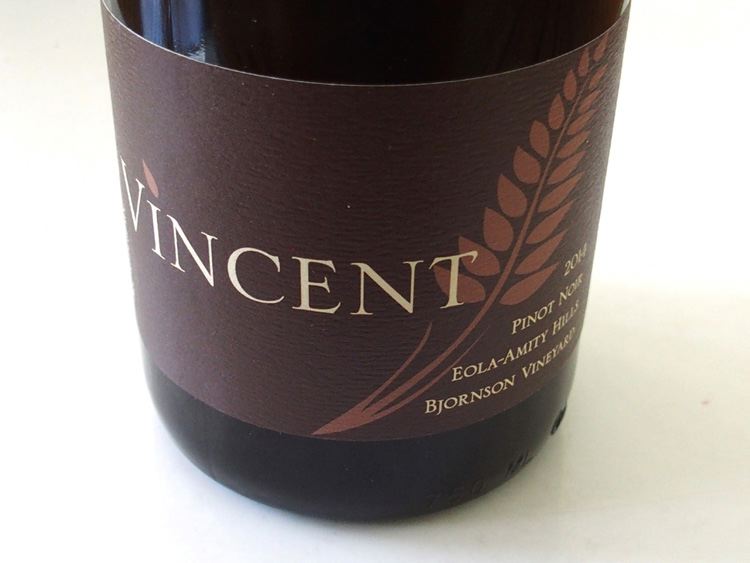 2014 Vincent Bjornson Vineyard Eola-Amity Hills Oregon Pinot Noir 12.9% alc., $39. · Moderately light reddish purple color in the glass. Fresh aromas of cherry and red berry lead off. Inviting balance and length, with middleweight flavors of cherry and red strawberry embellished with baking spices, finishing with a charge of succulent fruit. Score: 91
WildAire Cellars, GastonThis winery was founded in 2005 by Matt and Jean Driscoll after years of immersing themselves in the Willamette Valley wine scene. They started the journey in the mid 1990s by a chance visit to Oregon to attend a friend’s wedding. After getting married in 2000, they moved from Virginia to learn all aspects of the wine business in Oregon. Matt embarked on multiple vintages of winemaking experience and oversees the production for WildAire, while Jean focuses on sales, marketing and the business side of the winery. Besides their single vineyard, Reserve and Timothy Pinot Noirs, they produce Chardonnay, Riesling, Tempranillo and Syrah. Visit the website at www.wildairecellars.com.
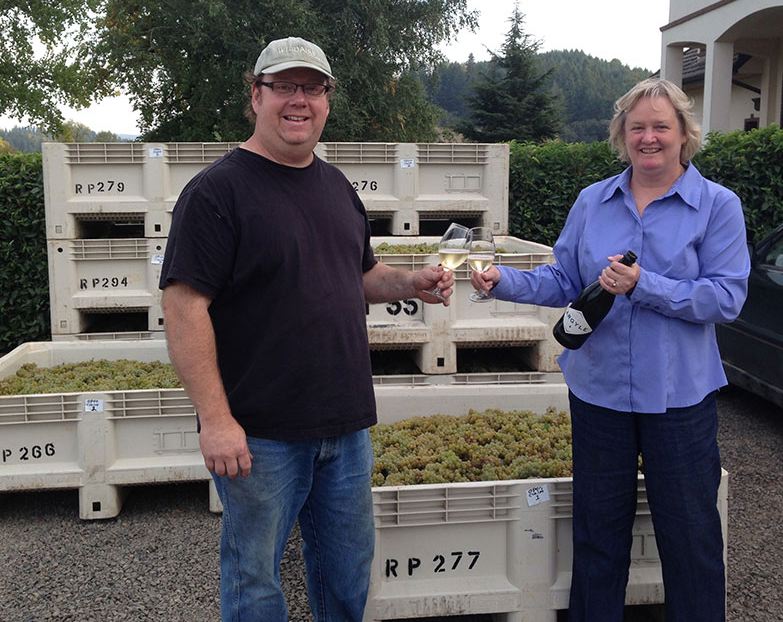
2014 WildAire Timothy Yamhill-Carlton Oregon Pinot Noir 14.5% alc., pH 3.71, 293 cases, $35. Released April 2016. Named to honor Matt Driscoll’s father. The wine is composed of the cellar’s best barrels and varies from year to year. Sourced from Yates Conwill Vineyard (Pommard and 777) and Beacon Hill Vineyard (Pommard). Harvest Brix 25.0º. 100% de-stemmed, 10-day cold soak, both native and inoculated yeasts, 25 days on the skins, aged 14 months in 33% new French oak barrels. · Moderately light reddish purple color in the glass. Very shy aromas of cherry, woodland and spice. Much more expressive in the mouth, with an explosion of blueberry, pomegranate and marionberry fruit flavors that invade and saturate the palate. Accents of oak-driven spice and vanilla add interest. Toned tannins and spot-on acidity hold the fruit in check, creating a seamless impression. The finish is immense in this joyful wine. Score: 92
2014 WildAire Beacon Hill Vineyard Yamhill-Carlton Oregon Pinot Noir 14.5% alc., pH 3.71, 97 cases, $45. Released April 2016. The Beacon Hill Vineyard is located southeast of Gaston and certified LIVE. 29- acres are planted to multiple clones of Pinot Noir in marine sedimentary soils. This wine comes from an ownrooted block of Pommard clone that was planted in 1988. Harvest Brix 25º. 100% de-stemmed, 10-day cold soak, more than 22 days on the skins, aged 14 months in French oak barrels, 50% new. · Moderately light cherry red color in the glass. Outstanding nose with bright aromas of cherry, strawberry and herb field. This mid weight wine is primarily red fruited, offering seductive flavors of cherry and strawberry accented with savory herbs, baking spice and smoky, toasty oak. Impeccable balanced, with fine-grain tannins, juicy acidity and a persistent finish. When tasted the following day from a previously opened and re-corked bottle, the oak overlay had lessened and one can expect this to occur with more time in the bottle as this is a young wine. Score: 92
 2014 WildAire Yates Conwill Vineyard Yamhill-Carlton Oregon Pinot Noir 14.5% alc., pH 3.79, 99 cases, $45. Released April 2016. This LIVE certified vineyard is located just west of Carlton and shares a fence line with the famed Resonance Vineyard. 13 acres of high density plantings of Pinot Noir and Chardonnay in Willakenzie soils. Pommard and 777 clones. 100% de-stemmed, 10-day cold soak, inoculated with several types of yeasts, more than 28 days on the skins, and aged 14 months in French oak barrels, 50% new. · Moderate reddish purple color in the glass. This wine is blessed with plenty of luscious black raspberry, blackberry and purple grape aromas and flavors with just the right compliment of oak-driven vanilla and spice. Haunting and fruit-laden, with a velveteen mouthfeel, and supportive tannins, all adding up to one seductive Pinot Noir. Score: 93
More Wines
2014 Eola Hills Oregon Pinot Noir 13.4% alc., pH 3.90, TA 0.64, 24,500 cases, $19. Harvest Brix 23.8º average. · Moderate reddish purple color in the glass. Very aromatic, with scents of black cherry and oak spice. Soft and silky in the mouth, with a discreet core of cranberry and black cherry fruit embellished with toasty oak, finishing with good juiciness. Score: 88
2014 Illahe Estate Willamette Valley Oregon Pinot Noir 14.0% alc., $19. Illahe is Chinook jargon for “land, earth or soil.” Small lot fermented, basked pressed, barrel aged. Crafted from LIVE certified sustainable grapes, Salmon Safe. · Moderate reddish purple color in the glass. Nicely perfumed with blackberry, black raspberry, and black cherry fruits with a hint of terra-cotta and a whiff of volatile acidity. A polished wine with exquisite balance, offering a mid weight core of black cherry and black raspberry fruit, finishing with some length and a tug of oak. An entry level wine from a superb vintage offering great value. Score: 89
2013 Love & Squalor Willamette Valley Oregon Pinot Noir 13.0% alc., pH 3.65, TA 0.60, 1,100 cases, $28. Composed of grapes from eight vineyards. Pommard, 777, 667 and “828” clones. 100% de-stemmed, small-lot fermentations with native yeasts. Aged in most neutral French oak barrels (8% new, 4% twice-filled) for 18 months. · Light cherry red color in the glass. A lighter, forward drinking wine that is nicely balanced, but the herb-infused cherry aromas and flavors suggest under ripeness. This is a casual wine with a short finish that may benefit from slight chilling. Score: 87
2014 Westrey Abbey Ridge Vineyard Dundee Hills Oregon Pinot Noir 13.5% alc., 251 cases, $45. 18 days on the skins, racked directly to barrel, aged 12 months in French oak barrels, 20% new. · Moderately dark reddish purple color in the glass. Brooding aromas of darker raspberry fruit, smoke and tobacco lead off. Fairly bold and concentrated, with flavors of oak-kissed black cherry and a subtle petrol note. Nicely balanced with a sweet cherry and exotically spiced finish. This wine needs more time to integrate the oak, but the potential is obvious. Score: 90
Adelsheim Vineyard Breaking Ground Pinot Noir Celebrates 45 YearsDavid Adelsheim, along with spouse Ginny Adelsheim, founded Adelsheim in 1971. The first planting of Pinot Noir came a year later in the shadow of the Chehalem Mountains, and the first commercial vintage was offered in 1978. David has played a significant role, not only in the success of his winery, but in every facet of the Oregon wine industry. In 2012, he was given the Oregon industry’s highest honor by the Oregon Wine Board, the Lifetime Achievement Award. Here is a list of some of his accomplishments:
•Vineyard manager, winemaker and director of sales, marketing and accounting at Adelsheim.
To celebrate David’s 45-year commitment to Oregon’s Chehalem Mountains, Adelsheim Vineyard is releasing a special Pinot Noir from the Chehalem Mountains labeled “Breaking Ground” in July 2016. The name Breaking Ground reflects David’s desire to both stay in the forefront and continuously raise the bar of his brand and the visibility of the Oregon’s wine industry. The wine is made entirely from LIVE-certified Chehalem Mountains grown fruit from all three major soil types found on the Chehalem Mountains - marine sedimentary, volcanic basalt and windblown loess. The Breaking Ground Pinot Noir ($45) will be sold in retail outlets and restaurants in the United States and globally.
LIVE was formed in 1995 by a small group of winegrowers from Oregon's Willamette Valley. In 1999, LIVE was incorporated as a 501(c)(3) not-for-profit organization to independently certify the sustainable practices of winegrowers and wineries in the Pacific Northwest. LIVE uses a comprehensive set of rigorously applied, science-based standards and procedures that ensure both wine grape farming (vineyards) and winemaking production (winery) are as sustainable and have as minimal an environmental affect as possible. LIVE certification is one of the most authoritative sustainability accreditations in the wine world, requiring LIVE members complete a series of reporting requirements each year on their vineyard and winery to confirm their compliance with LIVE standards. LIVE Wines are independently certified to meet strict international standards for environmentally and socially responsible grape growing and winemaking in the Pacific Northwest. Currently, there are 316 vineyards (7,070 acres) and 41 wineries that are Live Certified Sustainable.
Logo for websites, farm and winery signs, not labels.
Logo for wines made from at least 97% fruit that meets vineyard certification requirements.
Logo for wines made in a LIVE-certified winery from at least 97% fruit that meets vineyard certification requirements.
Adelsheim was one of the first Oregon wineries, and the first winery in the Chehalem Mountains region. Today, the winery sustainably farms and manages eight estate vineyards on 183 estate acres in the Chehalem Mountains AVA, producing upwards of 40,000 cases of wine. The Adelsheim Estate vineyards are pictured below. All Adelsheim vineyards are LIVE certified, as are all the grapes purchased. The Adelsheim winery also meets LIVE certification standards. Therefore, all Adelsheim wines meet the high standard of being “Live Certified Sustainable.”
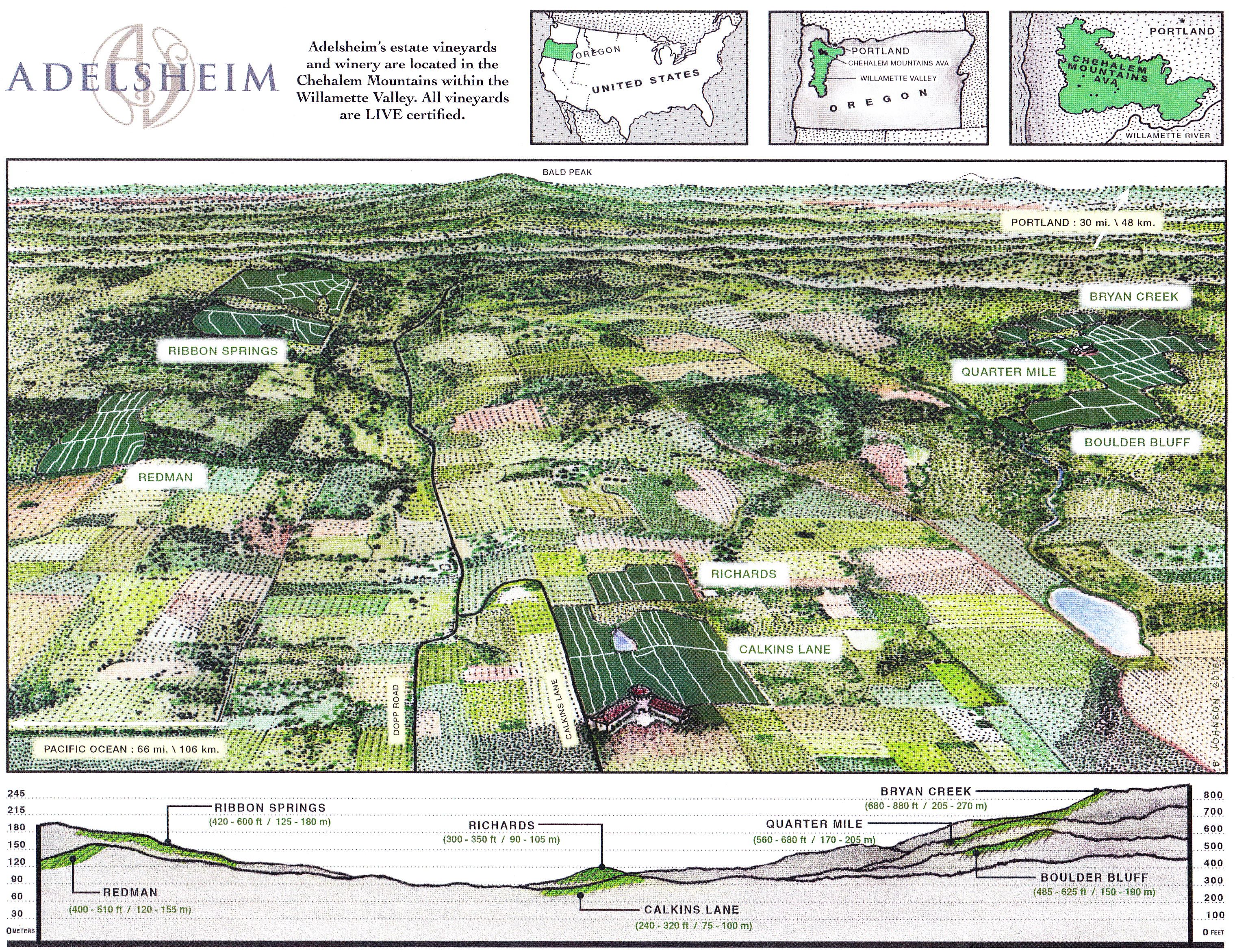 The winemaker at Adelsheim Vineyard since 2001 has been Dave Paige, a graduate of the University of California at Davis and the viticulturist and vineyard manager since 2006 has been Chad Vargas who holds BS and MS degrees in Crop Science and Plant Pathology. Adelsheim Vineyard is one of a few Oregon wineries open to the public 360 days a year. Visit the website at www.adelsheimvineyard.com.
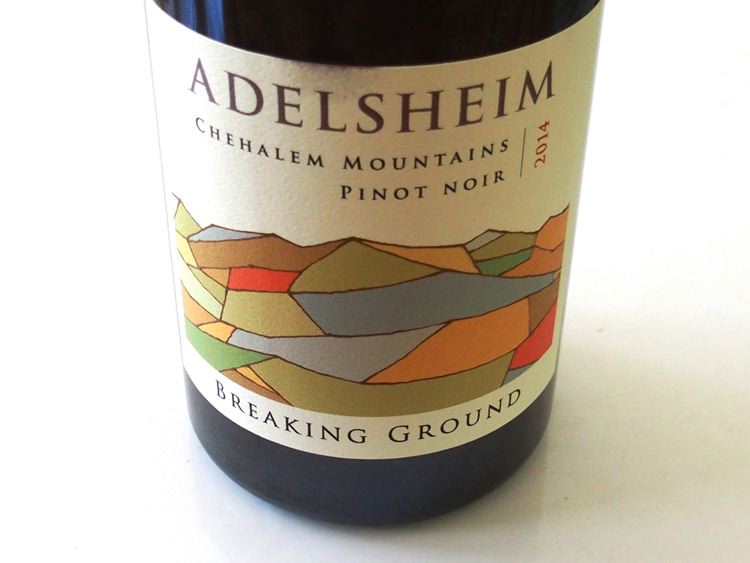 2014 Adelsheim Breaking Ground Chehalem Mountains Oregon Pinot Noir 13.5% alc., pH 3.55, 1,779 cases 750 ml, 22 cases of 6 1.5L bottles, $45. 88% estate fruit, 12% grower partners. Vineyards dry farmed and LIVE-certified. Aged 10 months in French oak barrels, 27% new. · Moderate reddish purple color in the glass. A pleasing combination of aromas greet the nose including black cherry, strawberry, earthy flora and nutty oak. Modest in weight with flavors of black cherry, blueberry and pomegranate. Beautifully balanced with soft, suede tannins, a good underlying cut of acidity, and the right touch of oak seasoning. A wine of great freshness, with noticeable intensity and length on the citrus accented, vivacious finish. A joyful ode to 45 years. Score: 92
Pinot BriefsOregon U.S. Wine Sales Near 3 Million Cases According to Impact Databank, Oregon wine sales reached 2.9 million cases in 2015, led by Pinot Noir and Pinot Gris that accounted for respectively 55% and 25% of volume. 90% of sales are above $11 a bottle, indicating Oregon has now become an important player in the premium wine market. Millennials, in particular, seem to include Oregon along with Washington and New York in their wine purchase choices. According to the Oregon Wine Board, 70% of Oregon’s 676 wineries produce less than 5,000 cases annually. Shanken News Daily notes that the upscale skew in Oregon wine prices can also mean higher operating costs for wineries since growing cool climate Pinot Noir is a costly proposition. Because of large vintage variations and low yields, it is challenging for Oregon to keep price and quality consistent. Oregon Lags in Monthly Visitors Oregon’s wineries are near the bottom in average monthly visitors per winery in the United States. This is advantageous for visitors, because wineries tend to be both receptive and attentive.
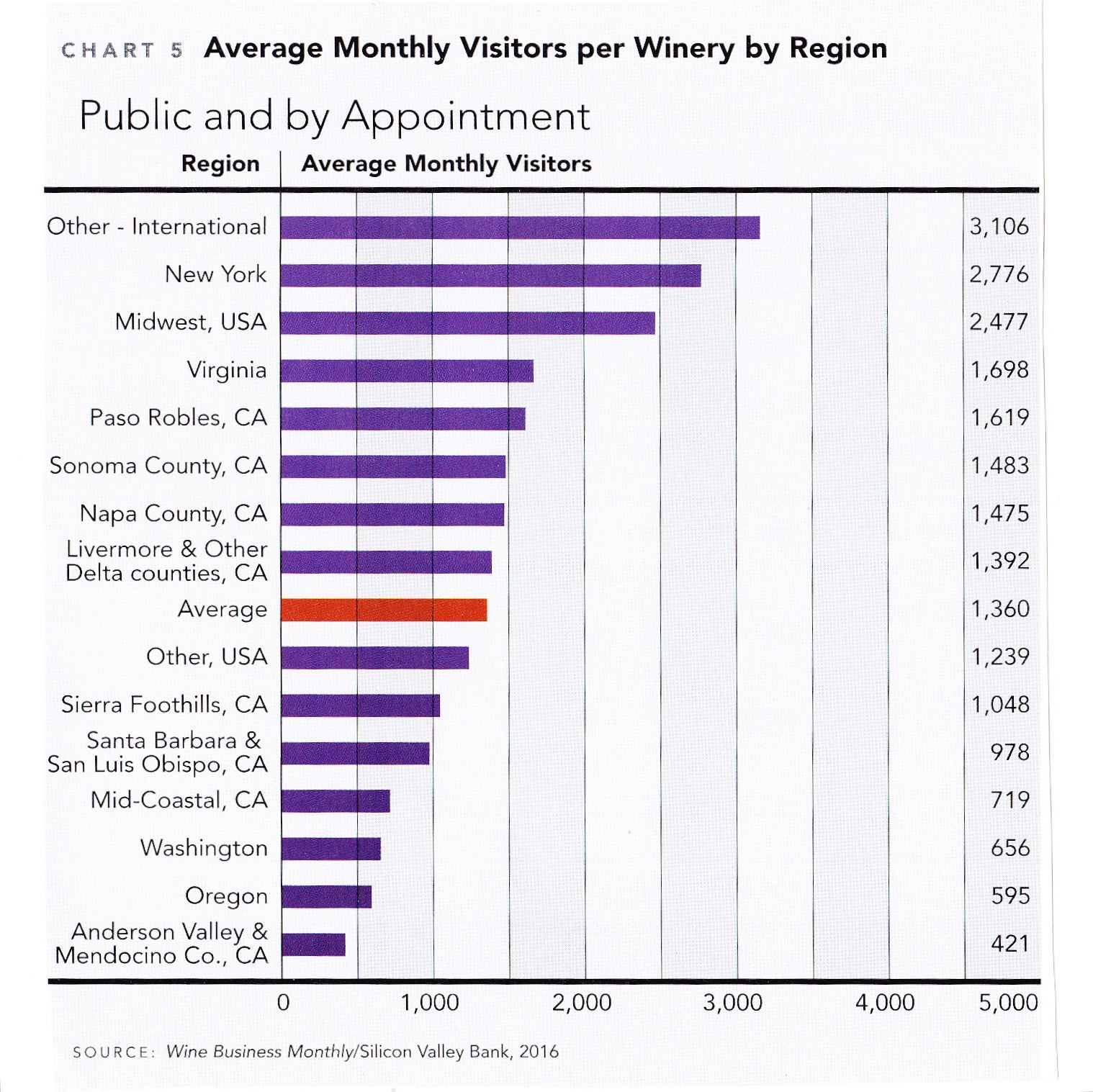 Helicopter Wine Tours Gain Popularity in Oregon According to an article in the Portland Tribune (March 8, 2016), helicopter tours for tasting are now more affordable and thus more accessible. Tour DeVine by Heli charges $399 per person for a 4-hour tour that includes 90-minute stops at two different wineries in a single AVA as well as morning champagne and snacks and a boxed picnic lunch by Red Hills Market. There are currently over a dozen winery partners allowing guests to customize their tasting tour. Visit www.TourDeVinebyHeli.com. Oregon’s Other Pinot Noir Region Southern Oregon is an officially designated American Viticultural Area since 2004, and is home to about 100 wineries and 3,000 acres of vines spread throughout the Rogue, Umpqua, Illinois and Applegate valleys that dot the landscape from Roseburg south to Ashland. One of the best kept secrets is that a number of Willamette Valley wineries source Pinot Noir grapes from the Umpqua Valley and Rogue Valley, especially in challenging cool vintages since these more southerly regions are warmer and can be more productive in certain vintages. Of the 29,000 tons of Pinot Noir crushed in 2012, 1,436 tons came from the Rogue Valley and 901 tons from the Umpqua Valley. Pinot Noir producers in Southern Oregon that are worth a visit include Brandborg Winery & Vineyards, DANCIN Vineyards, HillCrest Vineyard, Reustle-Prayer Rock Vineyards and River’s Edge Winery. Some Oregon Vineyards On Borrowed Time Phylloxera is a widespread pest in Oregon vineyards and once it gets enough presence in a vine, it is impossible to eradicate. Oregon fights to save its pest-ridden vineyards, since these vineyards are own-rooted, and many vintners feel own-rooted vines make the best Pinot Noir. Most of these own-rooted vineyards were planted before 1980, while the majority of Oregon’s vineyards planted since are on phylloxera-resistant rootstock. Phylloxera showed up in Oregon in the late 1980s. Phylloxera is not the only pest wine growers are facing. According to an article in the May 1, 2015 issue of Capital Press, Oregon State University’s Wine Research Institute has issued a warning that Oregon wine grape growers can expect increased pressure from brown marmorated stinkbugs in particular and spotted wing drosophila to a lesser degree. Both pest feed on tree fruit and berries (including grape berries) and are two of agriculture’s most damaging pests. Sta. Rita Hills Wine and Fire Event The 2016 Sta. Rita Hills Wine Alliance’s annual event, Wine and Fire, will take place August 5-7 at multiple locations throughout the Lompoc Valley. Year 2016 marks the 15 year anniversary of the Sta. Rita Hills AVA designation. Over 40 Alliance members will participate in three events over the weekend including the Friday night Barn Party at Hilliard Bruce Vineyards, the Saturday morning seminar on vineyards on Highway 246 and a look back at the past 15 years of the AVA, also be at Hilliard Bruce Winery, and Saturday evening’s Grand Tasting at La Purisima Mission. Alliance members will also be hosting open houses and special events throughout the weekend. For details and ticket information, visit the Wine and Fire page at www.staritahills.com. California Wine Institute Santa Cruz Mountains Road Trip The Wine Institute’s California Wines Road Trips series highlights a different region each month. This month, Santa Cruz Mountains is featured. Home to more than sixty wineries tucked into hillsides, Santa Cruz Mountains is one of California’s first AVAs (1981), and among the first to be defined by its mountain topography. This broad region is marked by diverse microclimates, with Pinot Noir and Chardonnay the stars on the coastal side and Zinfandel, Cabernet Sauvignon and Merlot predominating on the warm eastern inland side. There are several wine trails to explore, including the Summit to Sea Wine Trail, the Corralitos Wine Trail and the Saratoga Wine Trail. The beach town of Santa Cruz offers several urban wineries as well. Visit www.discovercaliforniawines.com for more information and an interactive map. Contact me for recommended Pinot Noir specialists in the region.
 Family Winemakers Tasting This extensive tasting of wines from smaller family owned wineries will be held August 21, 2016, at Pier 27 Cruise Terminal in San Francisco. This is an opportunity to taste over 500 wines offered by 125 wineries including upwards of 40 varietals or blends. Consumer tasting is 2:00 p.m. to 5:00 p.m. and Trade tasting is 12:00 p.m. to 5:00 p.m.. For information and tickets, visit www.familywinemakers.org. Delicato Family Vineyards Acquires River Road Vineyard Delicato Family Vineyards has acquired the historic 243-acre River Road Vineyard in the Santa Lucia Highlands from the McFarland family. This pioneering vineyard was first planted in 1972 by the late Jerry McFarland and was a forerunner of the current successful Pinot Noir and Chardonnay plantings in the region. It is located at the northern end of the Santa Lucia Highlands, bordering Sleepy Hollow Vineyard to the north and west (Sleepy Hollow Vineyard was also planted in 1972). The Indelicato family has a long tradition of grape growing in Monterey and their vineyards include San Bernarbe Vineyard in Monterey’s San Bernabe sub-AVA. What Yeast At Work During Fermentation? An interesting article appeared in the June 2016 issue of Wine Business Monthly (“Fermenting About Recent Yeast Research” by Curtis Phillips). University of British Columbia professor Dan Durall has studied yeast in winery fermentations for five years and presented his findings at the last Innovation + Quality conference. Durall found that an inoculated fermentation was usually dominated by the inoculated yeast strain, but about 30 percent of inoculated fermentations in his study ended up with some other commercial wine yeast strain forming 21 to 100 percent of the yeast population at the end of fermentation. Spontaneous fermentations always or nearly always ended up being a spontaneous fermentation of a commercial rather than an indigenous or “wild” yeast strain. Durall concluded that spontaneous fermentations are not “wild,” “indigenous,” or “native.” Instead, he suggested that the term “feral” was more appropriate. Curtis Phillips pointed out that spontaneous fermentations are usually dominated by whatever commercial wine yeast strains happen to have been used in or around the winery in the past. He also emphasized that inoculation with a commercial yeast strain is not a guarantee that the strain will be the one that ends up dominating a fermentation. Many wineries use the terms native, wild or indigenous to emphasize they do not add yeast to the fermenter, and this is often a marketing tool that suggests a purer, even more natural approach to winemaking. Durall’s research would seem to refute this idea that fermentations can be totally driven by wild yeasts that come into the winery on grapes or inhabit the winery (unless the winery has never used a commercial yeast and the vineyard is relatively isolated). I think I will try to use the term “feral” in my wine reviews in the future. ØENO (ee-no) Vaults Handles Wine Buying Logistics A cellaring solution that assists wine enthusiasts visiting Northern California’s wine country. Travelers can create an account through the web or mobile app, email Øeno Vaults the wine purchase orders or use the web or mobile app to submit wine pick up requests, and keep track of your wine inventory online or with OV Mobile. The wine is picked up from any area winery in a refrigerated truck and taken to the Øeno Vault facility. Each bottle is then inventoried, photographed and stored in an armed, climate controlled private vault with 24 hour surveillance and climate monitoring. Wines are then shipped to the customer from their vault wherever and whenever they wish. Tours of the facility are available. For information, visit www.oenovaults.com.
Will the Bloom Fall Off The Pinot Grape?Recently there have been a few warnings about impending doom for the continued success that domestic Pinot Noir has enjoyed post-Sideways (after 2004). This is notwithstanding that Pinot Noir wine has shown a 12% growth rate in off-premise sales during the past 52 weeks, according to the market research firm IRI. This growth rate is twice that of domestic wine generally. According to Statista, Pinot Noir rose 41% in consumption since 2008. Pinot Noir has shown a 65% increase in plantings in California over the past 10 years (2006-2015), with 39,931 acres currently, compared to only an 8% increase for Cabernet Sauvignon and a -18% decrease for Merlot. At the recent Anderson Valley Pinot Noir Technical Conference, Glenn McGourty, the executive director of the Mendocino County Farm Bureau, prepared a report presented by Devon Jones that warned that cheap Central- Valley-grown Pinot Noir threatens to ruin the image of the varietal in California. There is a rapidly growing demand for Pinot Noir, but high-quality California coastal grapes are in short supply, and producers may have to turn to using Pinot Noir grapes from the Central Valley that are of lower quality and cheap ($443 to $710 a ton) compared to coastal Pinot Noir grapes ($1,802 to $3,530 and more a ton). McGourty warned this potential trend may have a damaging long-term effect on the image and popularity of California Pinot Noir. Richard Ward, co-founder of Carneros Pinot Noir producer, Saintsbury, told www.thedrinksbusiness.com (June 2016), “Despite the popularity of Pinot Noir in the US, selling Pinot Noir in North American has become increasingly difficult, even for an established brand like Saintsbury, which was founded in 1981.” Ward pointed out that 10-15 years ago, there were probably 10% as many Pinot Noirs as there are being made today in California. He said, “I thought I had a deal with Cabernet producers in Napa. I didn’t make Cabernet and they didn’t make Pinot Noir - but they are all making Pinot now.” Compounding the problem is the disappearance of small distributors and the shrinkage in number of distributors, so that, “The sheer number of American Pinot Noir brands means that the market is totally saturated so it is hard unless you are important to distributors’ bottom line.” Wineries have to turn to selling direct to consumers. Matt Kramer posted a web feature article at www.winespector.com (June 21, 2016) titled “Has Pinot Noir Peaked?” Kramer stated, “We’re probably at the peak of selling this much Pinot Noir at the prices currently being asked. Pinot Noir is now the iPhone of fine wine. It likely has reached market saturation and very likely cannot significantly grow sales, at least at the prices being asked now.” What does this mean to the vast number of Pinot Noir producers that are producing a limited number of cases of Pinot Noir annually? They have to become smarter about marketing their wines direct to the consumer. It is not enough to have a creative and modern website that is succinct and easy to navigate because there are many of those. The trumpeted message is most often trite and the same on every other winery website, emphasizing family ownership, artisan and limited production, wines of character that capture terroir, blah, blah, blah. No matter how much the winery raves about its inspiration and its distinct wines, the message comes across as contrived self-promotion and advertising. The most important aim for a small Pinot Noir producer should be to achieve and emphasize independent verification of wine quality. It is not enough to simply note a score, since there is an ocean of domestic Pinot Noir that have received scores of 90 points these days. Complete reviews of the wines from respected sources should be linked, as well as any articles about the winery or winery personnel. The Prince of Pinot website at www.princeofpinot.com is the only Pinot Noir review source that welcomes open and easy linking of wine reviews and winery features published in The PinotFile to winery websites. As a champion of the small producer seeking a voice and recognition, I offer this marketing option for wineries at no charge, yet almost no wineries take advantage of this innovative feature of my newsletter. To link to an article or review about your winery, go to The Prince of Pinot Home Page at princeofpinot.com. Click on Wineries and Vineyards. Click on your winery. In the information box under the winery name, there is the wording, “How to link to an article or review about your winery.” Click on this and your will see link information for your winery including links to the detail page about your winery, links to feature articles on your winery, and links to specific tasting notes within an article. This information should be passed along to winery public relations consultants. Consumers can also use this feature as another way to quickly look up specific articles and wine reviews published in The PinotFile. |